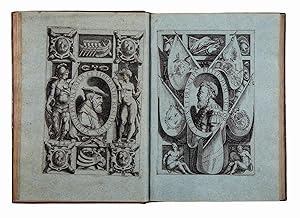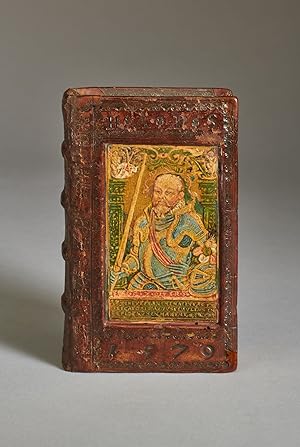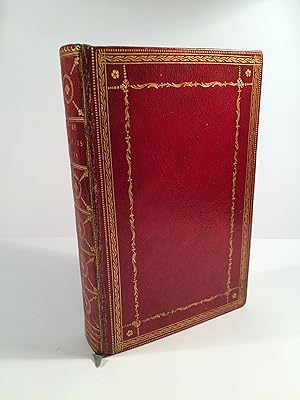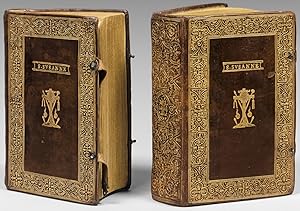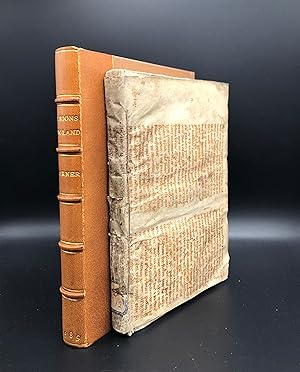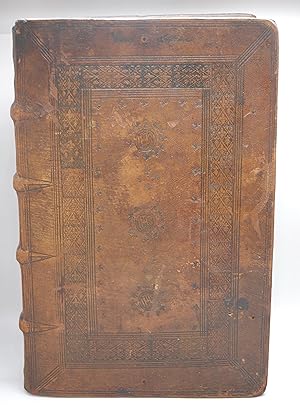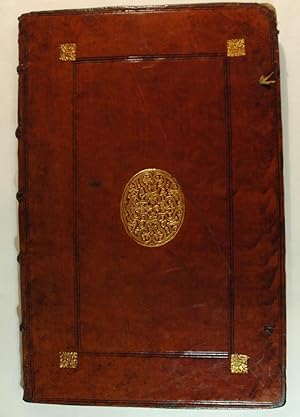biographies (Plus de 3 000 résultats)
Type d'article
- Tous les types d'articles
- Livres (3 027)
- Magazines & Périodiques (1)
- Bandes dessinées
- Partitions de musique (1)
- Art, Affiches et Gravures (30)
- Photographies
- Cartes (5)
-
Manuscrits &
Papiers anciens (3)
Etat
Reliure
Particularités
- Edition originale (194)
- Signé (160)
- Jaquette (422)
- Avec images (2 652)
- Sans impression à la demande (3 066)
Livraison gratuite
Pays
Evaluation du vendeur
-
Autograph letter signed ("Martinus LütheR D").
Edité par [Wittenberg, ca 1 Sept. 1543]., 1543
Vendeur : Antiquariat INLIBRIS Gilhofer Nfg. GmbH, Vienna, A, Autriche
Manuscrit / Papier ancien
Folio (200 x 307 mm). 2 pp. German manuscript (brown ink) on paper (watermark: letter F in circle). An extensive, uncommonly well-preserved letter to Georg Buchholzer (1503-66), Provost of St Nikolai in Berlin, regarding the latter s altercation with the Brandenburgian court preacher Johann Agricola from Eisleben (1492-1566, also known as "Magister Eisleben") about the treatment of the local Jews. Prince Elector Joachim II, who in 1539 had introduced the Reformation to Brandenburg and whose tolerant politics toward Jews enraged the population, had long desired a reconciliation between Luther and his former disciple Agricola, and he must have suspected that Provost Buchholzer was poisoning Luther s mind against his court preacher. Buchholzer therefore wrote to Luther requesting an interpretation of some Biblical verses by which Agricola justified his pro-Jewish stance, and in his answer Luther insists that Buchholzer has done well to preach against the Jews and shall continue to do so, ignoring the habitual liar Agricola: "Grace and Peace. My dear Provost! I must be brief with writing, for the sake of my weak head. You are aware that you have no previous association with me, nor I with you, other than that you recently wrote to me asking for an explanation regarding several statements. And even if you were to write me many things about M. Eisleben, how could I believe you alone? For whoever says that you or anyone in Berlin or in all of Brandenburg is inciting me against Eisleben, if he says so unwittingly, may God forgive him, but if he says it knowingly, then he is a roguish liar, as well as M. Eisleben himself has lied frequently, here in Wittenberg. M. Eisleben needs nobody to incite me against him; he himself is much better at that, much better than anyone whom he might suspect of such dealing. He knows that full well. [.] In my opinion, he will give up his life before he gives up his lying. You have preached against the Jews and fought serious battles over that with the Margrave. [.] And you were quite right to do so. Stand fast and persevere! The words against you which you quoted to me, allegedly protecting the Jews, I will not hope to be true, nor shall I believe that M. Eisleben ever will preach or ever has preached such. I do not yet consider him so deeply fallen. May God prevent him! [.] For then M. Eisleben would not be the Elector s preacher, but a true devil, letting his sayings be so shamefully misused to the damnation of all those who associate with Jews. For these Jews are not Jews, but devils incarnate who curse our Lord, who abuse His mother as a whore and Him as Hebel Vorik and a bastard, this is known for certain. And anyone who is capable of eating or drinking or associating with such a foul mouth is a Christian as well as the devil is a saint. [.] You may show this letter to whomever you wish. I do not know, nor do I care, who wrote the other three letters from Wittenberg to Berlin. You will undoubtedly confess this to be the first letter you ever received from me. For your name and person were previously unknown to me [.]" (translated). - Luther had apparently forgotten that several years previously, in late 1539, he had answered a letter of Buchholzer s inquiring about Catholic rites still in use in Reformed Brandenburg. More notably, although Luther is writing to a fellow scholar, this letter is written in German so as that the recipient may show it "to whomever he wishes" that is to say, to the Elector himself, thus providing Buchholzer with a writ of protection against any suspicion which Joachim may harbour against him. - The Hebrew words "Hebel Vorik" (vanity and emptiness) are taken from Isaiah 30:7. They were part of a Jewish prayer in which Jews thanked God for having made them different from those peoples who worshipped "Hebel Vorik", though Luther construed the words as a code for Jesus Christ. - Luther s anti-Judaism had not always been this rabid as a young man he had spoken out judiciously against the traditional defamation of Jews and against all forms of forcible conversion but he soon grew increasingly bitter, and by 1543 his attitude was one of undisguised loathing. His most notorious antisemitic pamphlet, "On the Jews and Their Lies", was published only months before the present letter was written. With the same rhetorical skill with which he had previously ridiculed the papacy he now invoked a grotesque abhorrence of Judaism. As an embodiment of his sentiments in his later years, demonstrating how precisely the antisemitic church politics and discourse of the 1540s matched Luther s instructions, the letter has been quoted or paraphrased by several important biographies of the Reformer (cf. M. Brecht, Luther, vol. 3 [1987], p. 344; most recently: L. Roper, Luther [2016], p. 532 n. 33). - Less than two years later, in a letter dated March 9, 1545, Luther would write to Elector Joachim II directly, warning him against the "tricks" of the Jews, in whom he is said to have too much confidence, adding that he is "glad that the Provost [Buchholzer] is so severe on those Jews, which is a proof of his loyalty to your Grace; and I encourage him to continue in the path he has chosen". - Condition report: several corrections in the text by Luther s own hand. Date of receipt noted by Buchholzer at the foot of the verso page: "Received by me in Berlin on Wednesday after St Egyd [5 September] anno etc. 43." Slightly browned and brownstained throughout; traces of contemporary folds. Not noticeably wrinkled; no significant edge tears; a beautifully preserved specimen. - Provenance: before 1914 nothing more of the letter was known than the words branding Agricola an incorrigible liar ("will give up his life before he gives up his lying"), which Buchholzer had hurled at his adversary during a disputation as late as 1562, offering to show him the passage in Luther s letter. In the early 19th century, the editors of Agricola s writings confessed that such a.
-
Memoires du voiage de Constantinople de Jacques de Bracle seigneur de Bassecourt. Manuscrit du XVIe siècle.
Edité par No place, ca. 1570., 1570
Vendeur : Antiquariat INLIBRIS Gilhofer Nfg. GmbH, Vienna, A, Autriche
4to (210 x 135 mm). French manuscript on paper. 90 ff. Flemish Bastarda in black ink, 26 lines. Bound with 16 strictly contemporary specimens of Turkish silhouette paper, a series of 28 watercolours, heightened in gilt and two extensive, early 19th century manuscript additions (complete transcript of the the travelogue and a biography of the author). Slightly later vellum with ms. title. Unique, fascinating and unpublished manuscript containing the account of a diplomatic journey to the Ottoman Empire in 1570. Braeckle (1540-71), a Flemish physician, "assisted Charles Rym Baron de Bellem, Ambassador of Maximilian II in Constantinople, probably as a secretary. He wrote an account of his journey, which contains interesting details about the places he visited, the manners and customs of the inhabitants, incidents, etc." (Aug. Vander Meersch, in: Belgian National Biography II, 903). Leaving Prague on 13 March 1570, the mission passed through Vienna and then Hungary and Czechoslovakia before entering Ottoman territory, visiting the mosques and caravanserais of Sokollu Mehmed Pasha (c. 1505-79), Grand Vizier of Sultan Selim II (1524-74) who ruled the Turks at the time of Rym's and Braeckle's journey. Their stay in Constantinople lasted from 31 May to 12 August 1570, permitting the author to describe several monuments and works of art. During the journey back they travelled through Bulgaria, Serbia (they were held in Belgrade for nearly a month), and Hungary. The mission ended with their return to Germany on 23 October 1570. Jacques de Braeckle died shortly afterwards, in 1571. - The ms. is accompanied by a beautiful set of 28 original watercolours heightened in gilt. Showing Turkish people in traditional costumes, such illustrations were usually fashioned for sale to travellers in Constantinople or passed on to western merchants. However, as the present set includes the caravanserai of the diplomatic legation, it is extremely likely that these were created with the sole purpose of illustrating the diplomatic mission of Charles Rym, described within the present manuscript. The figures are captioned next to the subjects (16th century Italian script in black ink), indicating that the legends were recorded after the plates were collated and sewn together, or that they were included in books before insertion into the present volume. Among the illustrations are the caravanserai of the ambassadors to Constantinople, Sultan Selim II, the Mufti, costumes of Ottoman dignitaries and the military, a Persian, a Moor of Barbary, a lady in burqa, a Bulgarian, a giraffe, etc. The author of the Italian captions may have been the ambassador Edoardo Provisionali: he was responsible for several diplomatic missions and is known to have appreciated the Ottoman culture; furthermore, de Braeckle left Constantinople in his company (cf. Yerasimos). The manuscript is also bound with 16 remarkable specimens of 16th c. Turkish paper (title in French in pen on the first sheet: "papier de Turquie"). At the beginning of the volume is a transcription, calligraphed in an elegant French cursive of the early 19th century (18 unnumbered ff., black ink, 21 lines per page). The volume ends with a short biography of the author (2 pp., black ink, with the arms of de Braeckle). Yerasimos provides a detailed chronology of the journey, listing the major cities visited as well as monuments and curiosities noted by the travellers. - Only three manuscript copies of the present travelogue are recorded, mostly restricted to family use: two copies are in the National Archives of Belgium in Brussels (Fonds 692 Lalang, 8f., cf. Yerasimos); a third copy is bound in a miscellany and kept at the communal Archives of Ghent. - Binding rubbed, spine detached, in excellent condition internally. - Stéphane Yerasimos, Les Voyageurs dans l'Empire Ottoman (XIVe-XVIe siècles), Ankara, 1991, pp. 286f. Not in Blackmer or Atabey.
-
THE RUSSELL COLLECTION: BOOKS, BROADSIDES, AND EPHEMERA OF THE FRENCH REVOLUTION
Edité par 1571 - 1947, 1571
Vendeur : Second Story Books, ABAA, Rockville, MD, Etats-Unis
Edition originale Signé
The Russell Collection contains over 300 books, broadsides, and pieces of ephemera produced between the waning decades of the ancien regime and the fall of Napoleon Bonaparte. The collection was assembled in the early 1950s by William F. Russell (1890 - 1956), President of Columbia University's Teacher's College from 1949 to 1954. With material spanning the 16th to the early 20th century, the majority of the collection was produced between 1775 and 1800. Highlights include early editions of the 1791 and 1793 French Constitutions, letters written and signed by pioneering economist Anne Robert Jacques Turgot, and official documents signed by Robespierre and other members of the Comite du Salut Public. The Collection is comprised of the following components: 1) The French Monarchy and the Ancien Regime; 2) Ideological Roots of Revolution; 3) The Transition to Republicanism and Collapse of the Monarchy; 4) The National Convention and the Committee for Public Safety; 5) Historical and Contemporary Context; and, 6) Miscellanea (Ephemera, Manuscripts, and Books). Most of the printed material was published by one of the two major publishing houses in Limoges. This concentration of material from a single city offers perspective on the publication and distribution of political and governmental texts in a particular city or departement (one which was especially impacted by the Crown's frequently shifting tax and trade policies). It also provides important insight into the early work and career of Anne Robert Jacques Turgot, who served as intendant of Limoges from 1761 - 1774. Limoges was home to several printing houses which, at various times during the Monarchy and Revolution, were designated as official printers of government documents for the region. Most notable among these were the Barbou and Dalesmes families. Both families had been established printers for centuries, but the Barbou appear to have been too closely aligned with the ecclesiastical hierarchy - after 1791, all of the officially published material printed in Limoges was released by members of chez Dalesme. 1) The French Monarchy and the Ancien Regime A significant portion of the collection is made up of documents from the reign of Louis XVI, issued by the crown, members of the regime, and the Parisian Parlement in the two decades leading up to the Revolution. These items, ranging from royal decrees to trial testimonies, illustrate governmental practice under the monarchy, especially as it relates to trade policy and criminal justice. 2) Ideological Roots of Revolution The Russell Collection includes a number of books and tracts from writers crucial to the development of revolutionary thought and discourse in France during the 18th-century. First or early editions by Mirabeau, Raynal, Mounier, Marat, and Condorcet, written before and during the upheavals of the early 1790s, reveal the increasingly liberal and radical intellectual currents among France's intelligentsia. First or early editions of works by Jacques Necker and Turgot also appear, shedding light on abortive efforts at modernization during the various governments under Louis XVI. 3) The Transition to Republicanism and Dissolution of the Monarchy The full span of the National Assembly, from its foundations during the Brienne and Necker governments to its ceding of legislative authority to the National Convention, is captured through official printed documents (Royal and republican), periodicals, regionally-drafted complaints and instructions, and published addresses. Also included are first or early editions of the French Constitutions of 1791 and 1793, as well as various edicts and documents issued by Louis XVI during l'Assemblee Nationale. The formal inauguration of the National Convention (and the removal of all executive powers from the King) is represented both by an Extrait of the relevant Assembly session, and in an officially published broadside explaining "des motif d'apres lesquels l'Assemblee Nationale a proclame la convocation d'un Convention nationale, et prononce la suspension su Pouvoir executive dans les mains du Roi." 4) The National Convention and the Committee for Public Safety; A substantial component of the Russell Collection is comprised of material created by, or related to, the Convention Nationale and the Comite du Salut Public. Nearly 90 official decrees from the legislative body are present, in addition to numerous printed addresses, departmental complaints, and two officially published broadsides related to the trial of Louis XVI. Other highlights include printed decrees and orders from the Committee for Public Safety, a document issued by the Parisian Communards, and an order signed by seven members of the Committee. 5) Historical and Contemporary Context; A subset of the Collection is made up of books and pamphlets responding to the events of the Revolution, from contemporaneous accounts to late 19th-century histories. The works published during the 1790s and early 1800s, whether biographies of revolutionaries or socio-political commentaries, reveal the mix of horror, regret, enthusiasm and hope stirred up among emigres, international observers, and participants in the revolutionary melee. The texts printed after 1840 reflect the intensive, documentary approach of the French historians in the latter half of the century. 6) Miscellaneous Documents (regional, subject-specific, etc.). Also included are a number of items (ephemera and manuscripts) that are either subject specific and tangentially related to the French Revolution (i.e.; treatises on the French language, moral philosophy deduced from botanical studies, 17th century medicine), or specific to Limoges and the Haute-Vienne. The latter includes several 16th and 17th century manuscripts from Limoges and Orleans. Several 20th century books, inscribed to the collector W.F. Russell, appear in the collection as well. All items are in good or better condition, unless otherwise stated. To view.
-
[Vitas patrum - germanice]. Der altväter leben.
Edité par Augsburg, Anton Sorg, 25. IX. 1482., 1482
Vendeur : Antiquariat INLIBRIS Gilhofer Nfg. GmbH, Vienna, A, Autriche
Edition originale
Folio (214 x 296 mm). 391 ff., lacking only the final blank, otherwise complete. With 19 large Maiblumen initials, large woodcut frontispiece and 275 woodcut illustrations, all in contemporary colour. Contemporary boards, original covering replaced in the 17th century with tooled Spanish leather, boards with supralibros and a complicated brocade design of parallel curved and straight lines, small squares and discs, fixed with a metallic film and glue, painted in reddish gilt, silver, and black; somewhat worn, joints restored, clasps removed, preserved in a dark green cloth Solander box. An influential early work on the lives of the Saints of Christendom, each woodcut in vibrant contemporary colour. The first edition with this illustration cycle; second German edition overall. - This stimulating work is a collection of biographies of the so-called Desert Fathers, both male and female: early Christian hermits who retreated from secular life into the deserts to practice ascetism and a life of devotion. The earliest versions of these "Vitae" were written in the third and fourth centuries and were extremely popular in early monastic circles. There was never a standardized order or set of these texts; rather, they were adapted according to the varying focuses of the convents for which they were made. A special appeal of the printed editions is the great number of often highly vivid woodcut illustrations, which made it easier and more enjoyable to read and hear these stories. Our copy is furthermore heightened with handsome contemporary colouring. - Transmitted under the Latin title of "Vitae sanctorum patrum" or "Vitas patrum", this collection consists of stories about early Christian hermits who, from the third century on, had retreated from cities and villages to the deserts of North Africa and Asia Minor to lead a life of devotion and ascetism. There was never a canonical combination of texts that formed the corpus of the "Vitas patrum"; instead, the choice of texts could vary according to the focus of the respective institution that owned the book. From the sixth century onward, the Rule of St. Benedict recommended the "Vitas patrum" as essential reading for monks. St. Dominic was ardently devoted to the lives of the Desert Fathers, and the influence of these texts on the development of Western monastic culture can hardly be overestimated. Virtually every monastery owned a copy of this "textbook for ascetism" (another designation for these compilations of narratives). In the Middle Ages, these accounts of the lives, deeds, and sayings of the Saints were attributed to St Jerome, although he in fact wrote only three of the biographies: he was responsible for the lives of SS. Hilarion, Malchus, and Paul the Hermit. - The present German edition was preceded only by the one printed in Strasbourg before 1482, by the unknown "printer of the Antichrist". That edition contained only a reduced number of exempla from the original collection, but boasted sayings from sources other than the "Vitas patrum", making this a different and shorter work. For the considerably extended Augsburg edition at hand, the printer Anton Sorg added the Bavarian "Verba seniorum", a collection of about 750 exempla originating in Bavaria, ca. 1400. The printer s purpose was clearly to offer the most complete combination of the German texts on the subject. Apparently, this edition satisfied the demand with regards to content, as later editions were not augmented. - This is one of the most lavishly illustrated incunables printed in Augsburg. It is adorned with 276 woodcuts printed from 204 blocks. The opening full-page woodcut depicts six of the hermits in a landscape; apart from the full-page title cut (195 x 140 mm) and the author portrait showing St. Jerome (100 x 80 mm), the text illustrations measure ca. 73 x 68 mm. - Many of the stories are long adventures, calling for more than one illustration. The story of Malchus the monk, for example, is accompanied by four illustrations: against the insistent warnings of the abbot, Malchus leaves his convent in the desert to visit his native town in Syria to comfort his widowed mother. On their way, the travel group is taken captive by the Saracens. The abductors keep Malchus as their slave and shepherd, after a while urging him to marry a young Christian woman among the other captives. Since she is still married to another man, Malchus is appalled and tries to refuse the alliance. His captors threaten him badly, however, so he yields, and he and his new wife live together in chastity, eventually deciding to escape from the Saracens' camp. In preparation, Malchus slaughters two of his goats, makes bags of their skin, and takes the meat as supplies for their flight. On their way to freedom, they must cross a wide river, and they inflate the goat bags, floating to the other side in safety. - This narrative is remarkable because it invites the illustration of nudity, which would normally be considered indecorous within a pious book from a medieval point of view. While Adam and Eve and perhaps tortured martyrs might appear nude, the theme did not extend much further. Our story, however, explains that the Saracens' slaves were often naked, since their garments would fall to pieces and they were not provided with new ones. - The master of the Sorg cuts knew and used the Strasbourg compositions as models. It is clear that he did not make mere copies, but rather had to adapt the composition from a horizontal image to one that was nearly square. The resulting composition, focused squarely on the bodies in flight, offers a more vivid, physical illustration of the escape. The models for the second part, the exempla, must have been adapted from another source, possibly a manuscript, as the Strasbourg edition provided only four pictures for this part. It is also conceivable that the talented artist who designed the illustrations for the first part also invented the designs for the remaining w.
-
The legend named in latyn LegÄ"da aurea. that is to saye in englysshe the Golden legende . : which werke hath ben diligÄ"tly amended in divers places where as grete nede was
Edité par By Wynkyn de Worde, 27 August, London, 1527
Vendeur : Liber Antiquus Early Books & Manuscripts, Chevy Chase, MD, Etats-Unis
Hardcover. Etat : Fine. An excellent, complete copy bound in late 18th c. russia, gilt, hinges neatly repaired, corners bumped. Illustrated with a full page woodcut on leaf A1 showing an assembly of saints and martyrs, and 85 woodcuts in the text. Wynkyn de Worde's woodcut printer's device (incorporating Caxton's initials) on verso of final leaf. Text printed in Black Letter, in 2 cols of 46 lines. Title and imprint from colophon. Provenance: George Henry Arnold of Ashby Lodge (1791-1844), bookplate on front paste-down. The text is in very fine condition with minor blemishes as follows: scattered light spotting, discreet marginal repairs on leaves Q6, Q8, and Oo4. Tiny single wormhole in the opening leaves, short worm-trail and small wormholes in blank margins of closing gatherings. Other tiny wormholes in the text of the last few gatherings. A few minor marginal repairs. Full-page woodcut, first text leaf, and verso of final leaf lightly soiled, nearly-invisible repair to blank upper margin of first leaf. William Caxton's English rendering of one of the most popular and influential books of the Middle Ages: Jacopo da Voragine's 13th c. collection of lives and legends of the saints, the "Legenda Aurea"(ca. 1267). Caxton tells us that for his English version, first printed in 1483, he drew on Jean de Vignay's (ca. 1282-ca. 1340) French translation, Voragine's Latin original, and the medieval English version known as the "Gilte Legende". Caxton also added new text authored by himself. These included a series of Old Testament lives, beginning with Adam and Eve, and a life of St. Rocke, to which he appended the note, "translated out of Latin into English by me, William Caxton." Caxton's English versions of the biblical stories are of great importance. They are, in essence, the first English translations of sections of The Bible to appear in print. "The most comprehensive of all versions of the 'Legenda', Caxton's 'Golden Legend' augments by about one-third the original Latin. The most obvious difference between the Latin text and Caxton's edition is the greater comprehensiveness of the English work. Although four of the one hundred and eighty-two chapters now regarded as constituting Voragine's work are omitted in Caxton's version, he more than supplies for this deficiency by adding ten chapters on feasts represented in the post-Voragine accretions to the 'Legenda' and fifty-nine legends not found in the Latin. Of the one hundred and seventy-eight chapters of Voragine represented in Caxton's version, seventeen are quite divergent."(Jeremy, "Caxton's Golden Legend", Speculum 1946) "He also restructured the work. Caxton collected the stories of Christ's life together, separating the feasts of the 'sanctorale' [feasts of saints] from the the 'temporale'[the other major days of the liturgical year], although certain fixed feasts that often belonged to the 'temporale'-including Stephen, John the Evangelist, Holy Innocents, Thomas Becket, and Candelmas-remained within the 'sanctorale' portion; he included new saints and new feasts, notably Corpus Christi; and he added a collection of Old Testament lives to be read on particular days of the year, beginning on Septuagesima, with Adam, and concluding on the last Sunday in October, with Judith."(Ring, "Annotating theGolden Legendin Early Modern England", Ren. Qtrly, Vol. 72, No. 3) The Printer: Wynkyn de Worde The book is a fine example of printing by Wynkyn de Worde, (d. 1534) William Caxton's protégé and eventually successor. De Worde worked for Caxton at Cologne, Bruges, and Westminster from 1471 until Caxton's death in 1492, at which point he took over Caxton's business. De Worde thrived as a printer and publisher, moving from Westminster to London (where he operated two presses) and established a dynamic marketing network. "Caxton'sdeath early in 1492 changedWynkyn'slife.Caxton'swill is not extant and althoughCaxtonhad a daughter,Wynkyntook over the business. The sacrist's rolls for Westminster Abbey indicate that from 1491/2Wynkynrented the shop by the chapter house, formerly rented byCaxton, at10s.a year. He paid this rent until 1499.Besides the premises formerly occupied byCaxton,Wynkyn rented rooms just outside the abbey from 1495/6 until 1499/1500. He began, afterCaxton'sdeath, by usingCaxton'sdevice, founts, and woodcuts. In 1500/01Wynkynleft Westminster for London, where he settled at the sign of the Sun in Fleet Street in St Bride's parish. By 1509 he also had a shop at St Paul's Churchyard at the sign of Our Lady of Pity [where this 1527 edition of the 'Golden Legend'.]"(Oxford Dictionary of National Biography) De Worde first printed an edition of Caxton's "Golden Legend" in 1493, omitting the stories from the Bible. From 1498 onward, De Worde published complete editions of the text. NINTH ENGLISH EDITION (1st 1483). Title and imprint from colophon.
-
Questiones super duos libros Peri hermenias Aristotelis .
Edité par [Colophon] Salamanca, (Juan de Porras), 1517., 1517
Vendeur : Richard C. Ramer Old and Rare Books, New York, NY, Etats-Unis
Edition originale Signé
Folio (29.5 x 20 cm.), contemporary blind-tooled morocco over boards, complex interlacing roll alternating with rows of circular punches between sets of 3 parallel lines; expertly rebacked, and corners mended; metal clasps refurbished. Magnificent large woodcut on first leaf of a scholar at his desk in a carefully depicted study, above the title (which runs to 6 lines of gothic type), all within woodcut borders. On verso of first leaf, a large Crucifixion above a smaller vignette of the Last Supper, all within woodcut borders. Full-page woodcut logical charts on ff. 54r and 119v. Text in 2 sizes of gothic type (for the Aristotle text and the commentary), woodcut initials, 2 columns. An extremely rare work, in very fine condition. Contemporary ink notations on front pastedown. 128 ll. [xciii misfoliated xcix, cxvii misfoliated cxviii], signed a4, b-q8, r4. *** First edition in this form of Aristotle's logical work De interpretatione, with commentary by Dullaert. It was edited by Dullaert's pupil Juan Martínez de Siliceo, who later became one of Spain's most famous Renaissance scholars. According to the Dictionary of Scientific Biography, Dullaert's commentary on De interpretatione was first published in Paris, 1509; the only copy of that edition we have been able to trace is located at the B.U.-Lille. The Catálogo colectivo lists Dullaert's commentary published by Étienne Baland (active in Lyons) in 1515, apparently edited by one Clodoaldus: the title-page reads, "a magistro Clodoaldo cenalis . de nouo puribus mendis absterse." This Salamanca, 1517 edition, according to the title-page, was edited by Juan Martínez Siliceo "ut paulo tersiora quaeque fuerint excuderentur." We have located no other edition of Dullaert's commentary edited by Martínez Siliceo.Aristotle's Peri hermeneias, also known under its Latin title De interpretatione, deals with language as the expression of mind, beginning with the definition of noun, verb, denial, affirmation, proposition and sentence. Although at least one early authority doubted its authorship, there is strong external evidence that it is by Aristotle (i.e., Theophrastus and Eudemus wrote works that presuppose it), and the style and grammar seem genuinely Aristotelian. It is generally considered an early work of Aristotle, still showing Plato?s influence.The magnificent title-page woodcut had already been used at Salamanca late in the fifteenth century. The Crucifixion - Last Supper cut on the verso is closely copied after the material used in the missals printed for Lucantonio Giunta at Venice. The complex diagrams are probably original blocks for this publication.Jean Dullaert (1470-1513), an Augustinian friar born in Ghent, is known for his contributions to logic and natural philosophy. "The logical subtlety of Dullaert's endless dialectics provoked considerable adverse criticism from Vives and other humanists, but otherwise his teachings were appreciated and frequently cited during the sixteenth century" (DSB IV, 237). He published commentaries on Aristotle's Physica and De caelo in 1506 (subsequent editions in 1511 and 1512) and on Aristotle's Meteorologica in 1512 (reissued by Vives in 1514), as well as editions of works by Jean Buridan and Paul of Venice.The editor, Juan Martínez Siliceo (ca. 1486-1557), was an outstanding pupil of Dullaert's; the Dictionary of Scientific Biography notes that he and Juan de Celaya were "both important for their contributions to the rise of mathematical physics." In this posthumous edition of Dullaert's commentary, Martínez Sicileo apparently cut some parts he felt were repetitive or unnecessary. A native of Villagarcía in Extremadura, he studied and taught at the Sorbonne before moving to the University of Salamanca, and then serving as tutor to the the Infante D. Felipe. In 1541 he was named bishop of Cartagena, and in 1545, bishop of Toledo. The year before his death he was raised to the rank of cardinal, an event celebrated with an eighty-foot arch and an elaborate procession that was so well attended that several people were asphyxiated. Aside from his commentaries on Aristotle, he published several important works on mathematics, including Arithmetica, Paris 1526.The binding closely resembles one done in Salamanca, ca. 1503, illustrated in Penney's Album of Bookbindings (plate VII). Three different sizes of the interlacing roll used in the Hispanic Society's binding are used on our binding.NUC lists no edition of this commentary by Dullaert, and only one copy each of a few of his other works: his commentary on Aristotle's Meteorologica, Paris 1514, at NN; and editions of his commentary on Aristotle's Physics, (Paris) 1506, at NNAM and (Lyons 1512) at MH. A microfilm copy of the British Library's copy of Dullaert on Aristotle's Physics (Paris: G.L. Nicolaus Depratis, 1506) is at NNC.*** Norton 507: citing copies at Barcelona-Biblioteca Universitaria; León-San Isidoro; Oviedo-Biblioteca del Cabildo; Seville-Biblioteca Universitaria; Lisbon-Biblioteca Nacional; and an incomplete copy at Burgos, Biblioteca Provincial. Ruiz Fidalgo 117: adds a copy at Salamanca-Biblioteca Universitaria; on Juan de Porras, see I, 37-43. Witten, Catalogue Six: One Hundred Important Books and Manuscripts 32 (1975). Not in Palau. Not in the Catálogo colectivo, which locates Dullaert's commentary edited by Clodoaldus, (Lyons): Bland, 1515, at the Biblioteca Pública of Palma de Mallorca (D.1638). Not in Adams. This work not listed with Martínez Siliceo's others by Simón Díaz (cf. XIV, 361-2). Cf. Picatoste y Rodríguez, Biblioteca científica española pp. 183-5 for other works by Martínez Siliceo. See also Lohr, Latin Aristotle Commentaries, II: Renaissance Authors, pp. 128-9; 246. CCPBE locates three copies: Oviedo Cathedral, Biblioteca Pública del Estado en Burgos, Real Colegiata de San Isidoro-León. Not located in Jisc. Not located in KVK worldwide (51 databases searched). Not located in NUC.
-
Couverture rigide. Etat : Très bon. 800x600 Normal 0 21 false false false FR X-NONE X-NONE MicrosoftInternetExplorer4 Exceedingly rare first French edition dedicated to Anne of Brittany and first issue of ?De la louenge et vertu des nobles et clères dames? by Giovanni Boccaccio printed on the 28th of April 1493 by Antoine Vérard. BMC VIII 79 ; B.n.F. Rés. G-365 ; Brunschwig 280 ; CIBN B-519 ; Fairfax Murray, FB 50 ; Goff B-719 ; GW (+ Accurti I) 4490 ; HC 3337 ; IGI 1769 ; Macfarlane 25 ; Pell. 2478 et 2478 A ; Hain-Copinger, n° 3337 ; Proctor n° 8425 ; Brunet, I, 990. This copy is the only one complete to appear on the international market since 30 years. The first Latin edition was published in 1473 under the title De Claris mulieribus (some famous women), in Ulm. ?The work, written between 1360 and 1362, amplified and modified in the following years, contain the biography of 104 renowned ladies of all times, from Eve to the Queen Joanna of Naples; it is dedicated to the very beautiful Andrée Acciaiuoli, sister of the Grand Seneschal Nicolas Acciaiuoli, second wife of an Altavilla Count. The model of Petrarch and of his treaty of Notorious Men greatly influenced Boccaccio, as he admitted himself. The narrative vein is expanding there with a certain, freedom, like in the pages dedicated to the life of the Popess Joan, to the voluptuous lengths on the loves of Thisbe, to the history of the naïve Paulina, Roman woman loved by God Anubis, recalling quite closely the tale of Lisette and Angel Gabriel from the Decameron. ( ) As a whole, the volume is a compromise between the historical scholarship and the tale, a pleasing erudition book, aimed not only at men but also women, - whom, declares Boccaccio, as an excuse, being used to hear stories have a greater need of it and enjoy themselves with a copious story.? T.F. G. Rouville. The volume is illustrated with 11 woodcuts that, since repeated, form an iconographical cycle of 80 engravings. Most of them measure 87 x 80 mm and represent a queen with a child in her arms (23 times), a queen standing with some ladies in front of her (22 times), a woman breastfeeding twins in front of a landscape (17 times). Two other engravings come from the Chevalier délibéré, printed in 1488. Two engravings of different sizes, 140 x 86 mm, show a bishop at his writing case topped with a sage and a woman; they come from the ?Ars moriendi? printed by Le Rouge for Vérard, in 1492. Nine of these engravings were specially executed for this book and are therefore here in first issue. ?Extremely rare volume, illustrated with a certain number of beautiful woodcuts which are among the most interesting ones from the works published by Vérard?. (Rahir n°263). Copy including the signs of the first issue: - The title is printed with the mistake « nouellemet », corrected in the copy of the Pierpont Morgan Library. The Gesamt Katalog, Pellechet Polain 2478 and Hain mention « nouuellemet » with two U. - Leave i4 is signed hIIII. First great Italian prose-writer, Giovanni Boccaccio (1313-1375) was very famous in France, more than Dante and Petrarch, and this since the beginning of printing. He wrote as much for the people, who enjoyed the entertaining reading of the Decameron, as for the aristocracy who, in the De casibus virorum illustrium (translated into French Le cas des nobles malheureux), found a kind of ethical encyclopedia of the great men from the Antiquity. This first edition was printed by Antoine Vérard who dedicated the work to Anne of Brittany, wife of King Charles VIII. It was for the most part due to writers engaged by Anne of Brittany, or attracted by the possibility of her patronage, as Antoine Vérard could be, that literature to the praise and defense of women was promoted in the French court. The title only contains two lines of text. On the back of the title begins the translator?s preface, suppressed in some copies and supplemented with a miniature. In this copy it is coming with a woodcut showing the Queen Anne of Brittany seated.
-
Le Vite de' piu eccellenti Pittori, Scultori et Architettori, Scritte, & di Nuovo Ampliate da M. Giorgio Vasari Pit. et Archit. Aretino. Co' ritratti loro et con le nuove vite dal 1550. insino al 1567.
Edité par Giunta., Florence., 1568
Vendeur : Sims Reed Ltd ABA ILAB, London, Royaume-Uni
Livre Edition originale
3 parts in 3 vols. 4to. Woodcut pictorial title with architectural border to each vol. (the first showing the waking of the souls of dead artists, the remainder with the Medici arms), portrait of Vasari and 144 woodcut portraits after designs by Vasari or his pupils, each with title and within six differing borders of female figures representing the arts (woodcut portrait of Giulio Genga in vol. III with cancel slip correcting title), historiated or decorated woodcut initials and head- and tail-pieces throughout. Full seventeenth-century Italian red morocco, boards with gilt-tooled borders and gilt rules to surround central armorial vignettes, banded spine with title and decoration in gilt, turn-ins with gilt tooled borders, a.e.g. [PROVENANCE: Bookplates of Adélaïde Suzanne de Laborde (1753 - 1832) to front pastedown of each vol. with the text 'Bibliothèque de Madame de la Borde'; Jean Gardiner Kinnear (1794 - 1865) with his arms to front and rear boards of each vol. - for additional detail see below]. The second edition of Vasari's famous 'Vite' but the first complete edition with much new material and the first to be illustrated. A magnificent copy in seventeenth-century Italian red morocco with large margins of the first Western history of art and one of the most important books of the Renaissance. First published in three parts in two volumes in 1550 by Lorenzo Torrentino, Vasari had provided biographies - with the exception of that for Michelangelo whom Vasari and his contemporaries idolised - of deceased artists only. Eighteen years were to pass before Vasari issued this second edition and he added so much new information that this second edition is considered preferable to the first. This second edition features woodcut portraits of the artists, adds a further 28 lives (including that of Titian), Vasari's own biography, a technical treatise on painting and updates much of the information in the previous edition to the year 1567. This copy with the variant title for vol. I (see Mortimer) with blank verso and without the Medici arms; in copies without the variant, the block for the title, here incorporated within the woodcut frame of the title, is printed on the verso. 'Vasari's excellent sense of narrative . and lively style combined with his wide personal acquaintance makes his 'Lives' a vital contribution to our understanding of the character and psychology of the great artists of the Renaissance, a term (rinascita) which he was the first writer to use . It [the 'Lives'] became a model for subsequent writings on the history of art . For its period it has remained the chief authority . '. (Printing and the Mind of Man). This copy was in the collection of Adélaïde Suzanne de Vismes (1753 - 1832), a poet and intimate of Queen Marie-Antoinette, who married the composer Jean-Benjamin de Laborde, a favourite of Louis XV and son of the financier Jean-François de Laborde, who became a 'fermier général'. In the nineteenth-century the Vasari passed into the collection of John Gardiner Kinnear (1794 - 1865), the Scottish financier, who had his arms stamped on the boards of each volume. [PMM 88; Brunet V, 1096; Cicognara I, 2391; Mortimer Italian II, 515; Arntzen H48a].
-
Le vite de' piu eccellenti pittori, scultori, e architettori [The Lives of the Artists]
Edité par Giunti, Florence, 1568
Vendeur : Manhattan Rare Book Company, ABAA, ILAB, New York, NY, Etats-Unis
Hardcover. Etat : Fine. 2nd Edition. FIRST COMPLETE, FIRST ILLUSTRATED, AND MOST SOUGHT AFTER EDITION OF THE FIRST MODERN HISTORY OF ART. [The Second Edition overall.] An exceptional copy, very handsomely bound. Vasari's "book contains the biographies of Italian painters, etc. from the thirteenth to the sixteenth century. They are based on earlier written and printed sources, on oral accounts, on his knowledge of works of art and his own collection of large drawings. Vasari traveled extensively to collect personal information, meeting most of the artists of his time. Michelangelo was his great hero. The Lives are freely laced with stories and anecdotes, some of which are certainly apocryphal. Vasari's excellent sense of narrative, however, and lively style combined with his wide personal acquaintance makes his 'Lives' a vital contribution to our understanding of the character and psychology of the great artists of the Renaissance, a term ('rinascita') which he was the first writer to use. It also contains an autobiography and a valuable treatise on the technical methods employed in the arts. It became a model for subsequent writings on the history of art. For its period it has remained the chief authority and new editions are published regularly" (Printing and the Mind of Man, 88). This second edition-the first illustrated and the preferred edition-comprises 161 lives, 28 more than the first edition of 1550 and it brings the biographies up to date from 1550 to 1568. The portraits were designed by the author himself (to his contemporaries he was first and foremost a painter and architect) and executed by or under the supervision of Maestro Christofano, probably either Christophoro Coriolano or Christoforo Chreiger. They are accurate and characterful representations of their subjects. Engraved with "architectural title-border, with figures and putti, on the title page of each of the three volumes. The inner border includes a shield with the Medici arms and a cartouche which contains. a view of Florence. The first volume of part three has a Giunta lily device on the title-page. On the verso of the title of the first volume is an allegorical woodcut. repeated at the end of part three. Portrait of Vasari printed as a plate. One hundred forty-four medallion portraits of the artists. set within borders with female figures representing the arts. There are six different border designs. [and] grotesque, arabesque and dolphin tailpieces" (Mortimer, Harvard). Florence: Appresso I Giunti, 1568. Quarto, early eighteenth-century full polished calf with elaborately decorated gilt spines. Three volumes. Light occasional foxing, title border a little shaved (as usual). Elegant early engraved bookplate in each volume. An early issue with illustrations in uncommonly strong, clear impressions. Third volume slightly smaller, light wear to bindings. All three volumes in exquisite uniform early calf.
-
Vita & fabellae Aesopi cum interpretatione Latina . Gabriae Fabellae tres & quadraginta . Phurnutus seu, ut alii, Curnutus De natura deorum. Palaephatus de non credendis historiis. Heraclides Ponticus de allegoriis apud Homerum. Ori Apollinis Niliacihieroglyphica. Collectio proverbiorum Tarrhaei, e Didymi, item eorum, quae apud Sudam aliosque habentur . Ex Aphthonii exsercitamentis de Fabula . De fabula ex imaginibus Philostrati . Ex Hermogenis exercitamentis De fabula Prisciano interprete. Apologus Aesopi de Cassita apud Gellium
Edité par Venice, Aldus Manutius, Venice, 1505
Vendeur : MEDA RIQUIER RARE BOOKS LTD, London, Royaume-Uni
Etat : Buono (Good). Folio (281 x 178mm). Text of Aesop and Gabrias in Greek and Latin, the others in Greek. Aldine anchor on title and verso of final leaf. Late 18th-century diced russia with gilt crest of Sir Richard Colt Hoare on spine, gilt tooling on covers and gilt edges. Neat marginal repair to wormhole in last three leaves, occasional light spotting and soiling, extremities lightly rubbed, spine neatly restored, overall a very fine copy from the libraries of Sir Richard Colt Hoare (1758-1838; his crest on spine, Stourhead sale 1883, lot 164) ? W.R. Jeudwine (bookplate; sale Bloomsbury 18 September 1984, lot 30) ? Helmut Friedlaender (booklabel; sale Christie's, 24 November 1993, lot 92) ? Livio Ambrogio (bookplate). First and only Aldine edition of Aesopus' Fables, both in Greek and Latin, in an heterogeneous compilation including two fable collections (one in prose, attributed to Aesop, one in verse, attributed to Gabrias, i.e. Babrius), a biography of Aesop by the Byzantine scholar Maximus Planudes, some short treatises on the interpretation of myths and the genre of the fabula, and a collection of proverbs. ?This edition may be considered among the rarer and more beautiful productions of the Aldine press.' (Frognall Dibdin). Aesopus' Fables are here increased in number in comparison to the editio princeps and are provided with a new Latin translation by Aldus, which would have enjoyed great fortune in the decades following its appearance. A special mention should be given also to two of the seven works being published here for the first time, the poetic fables erroneously attributed to Gabrias and Horapollo's Hieroglyphica, the only systematic essay on the interpretation of Aegyptian hieroglyphics to survive in its entirety from Classical Antiquity. In producing this edition, Aldus was confronted with the problem of putting together the Greek text and the Latin translation and with the resulting problem of the numeration of pages and leaves. The Greek text is thus numerated from page 17 to page 142 (with the only exception of pages 129-130), while the Latin translation presents no numeration at all and pages 142- 173 present a numeration in columns. Aldus was not, apparently, interested in editing Aesopus' Fables as an indipendent text; rather, the edition was intended as an anthology of poetic forms considered useful for grammar school exercise. In particular, by connecting the animal fables with tales on myths and anthropomorphic gods, he provided his reader with a refined linguistic and thematic inventory, susceptible to undergoing a reuse in the field of rhetoric. ?Aldus' edition of Aesop is essentially a collection of ?fabulae' (in the rhetorical definition of implausible narratives) and their interpretations; it closely corresponds to the forms recommended by Quintilian for the grammar school, especially in that it begins with the fables and ends with the proverbs? (W.P. Weaver, Untutored Lines. The Making of the English Epyllion, Edinburgh 2012, p. 50). Adams A-278; Ahmanson-Murphy 93; Renouard Alde, 49-50. Book.
-
Mathematicae Collectiones a Federico Commandino Urbinate in latinum conversae, et commentariis illustratae
Edité par Girolamo Concordia, Pesaro, 1588
Vendeur : SOPHIA RARE BOOKS, Koebenhavn V, Danemark
Membre d'association : ILAB
GREEK GEOMETRY - A CRUCIAL INFLUENCE ON DESCARTES. First edition of Pappus' Collection, translated with commentary by Federico Commandino, a princely copy from the notable collection of the great Papal family and patrons of learning, the Piccolomini, Dukes of Amalfi, thence by marriage to the German nobleman von Troilo. The Collection is "by far the most important of Pappus' works . without it, much of the geometrical achievement of his predecessors would have been lost forever . The Collection deals with the whole body of Greek geometry, mostly in the form of commentaries on texts which it is assumed the reader has to hand. It reproduces known solutions to problems in geometry; but it also frequently gives Pappus' own solutions, or improvements and extensions to existing solutions. Thus Pappus handles the problem of inscribing five regular solids in a sphere in a way quite different from Euclid; gives a broader generalization than Euclid to the famous Pythagorean theorem, and provides a demonstration of squaring the circle which is quite different from the method of Archimedes (who used a spiral) or that of Nicomedes (who used the conchoid). Perhaps the most interesting part of the Collection, measured by its influence on modern mathematics, is Book VII, which is concerned with the problems of determining the locus with respect to three, four, five, six or more than six lines. Pappus' work in this field was called 'Pappus' problem' by René Descartes, who demonstrated that the difficulties which Pappus was unable to overcome could be got round by the use of his new algebraic symbols. Pappus thus came to play an important, if minor, role in the founding of Cartesian analytical geometry. And it is another mark of his originality and skill that he spent much time working on the problem of drawing a circle in such a way that it will touch three given circles, a problem sophisticated enough to engage the interest, centuries later, of both François Viète and Isaac Newton. For his own originality, even if his chief importance is as the preserver of Greek scientific knowledge, Pappus stands (with Diophantus) as the last of the long and distinguished line of Alexandrian mathematicians" (Hutchinson Dictionary of Scientific Biography). "He formally defined analysis and synthesis as they are still commonly applied in the solution of geometrical riders. Pappus stumbled upon the projective invariance of the cross-ratio of four collinear points and other related results reclaimed by modern projective geometry; and he gave the first recorded statement of the focus-directrix property of the three conic sections. He formulated the 'centrobaric' theorems, frequently attributed to Paul Guldin (1577-1643), for calculating the volume and surface generated by a plane figure rotating about an axis in its own plane. He discussed theoretical mechanics, the equilibrium of a heavy body on an inclined plane, the use of the mechanical powers, and the construction of mechanical toys" (Biographical Dictionary of Scientists). Provenance: Ex libris inscription of Princess Maria Piccolomini and signature of Count Franz Gottfried von Troilo on title; shelfmark on front free endpaper. Pappus of Alexandria (c.â 290- c.â 350 AD) was the most important mathematical author writing in Greek during the later Roman Empire. Other than that he was born at Alexandria in Egypt and that his career coincided with the first three decades of the 4th century AD, little is known about his life. "In the silver age of Greek mathematics Pappus stands out as an accomplished and versatile geometer. His treatise known as the Synagoge or Collection is a chief, and sometimes the only, source for our knowledge of his predecessors' achievements. The Collection is in eight books, perhaps originally in twelve, of which the first and part of the second are missing . The several books of the Collection many well have been written as separate treatises at different dates and later brought together, as the name suggests . A. Rome concludes that the Collection was put together about AD 340, but K. Ziegler states that . the Collection may have been compiled soon after AD 320. It has come down to us from a single twelfth-century manuscript, Codex Vaticanus Graecus 218, from which all the other manuscripts are derived . "The portion of book II that survives, beginning with proposition 14, expounds Apollonius' system of large numbers expressed as powers of 10,000. It is probable that book I was also arithmetical. "Book III is in four parts. The first part deals with the problem of finding two mean proportionals between two given straight lines, the second develops the theory of means, the third sets out some 'paradoxes' of an otherwise unknown Erycinus, and the fourth treats of the inscription of the five regular solids in a sphere, but in a manner quite different from that of Euclid in his Elements, XIII. 13-17. "Book IV is in five sections. The first section is a series of unrelated propositions, of which the opening one is a generalization of Pythagoras' theorem even wider than that found in Euclid VI.31 . The second section deals with circles inscribed in the figure known as the Î Ï Î Î Î»Î¿Ï or 'shoemaker's knife.' It is formed when the diameter AC of a semicircle ABC is divided in any way at E and semicircles ADE, EFC are erected. The space between these two semicircles and the semicircle ABC is the Î Ï Î Î Î»Î¿Ï . In a series of elegant theorems Pappus shows that if a circle with center G is drawn so as to touch all three semicircles, and then a circle with center H to touch this circle and the semicircles ABC, ADE, and so on ad infinitum, then the perpendicular from G to AC is equal to the diameter of the circle with center G, the perpendicular from H to AC is double the diameter of the circle with center H, the perpendicular from K to AC is triple the diameter of the circle with center K, and so on indefinitely. Pappus records this as 'an ancient.
-
[Ship of Fooles] Stultifera nauis, qua omnium mortalium narratur stultitia, admodum vtilis & necessaria ab omnibus ad suam salutem perlegenda, è Latino sermone in nostrum vulgarem versa, & iam diligenter impressa. An. Do. 1570. The Ship of Fooles, wherin is shewed the folly of all states with diuers other workes adioyned vnto the same, very profitable and fruitfull for all men. Translated out of Latin into Englishe by Alexander Barclay priest
Edité par John Cawood, London in Paules Church, 1570
Vendeur : Heritage Book Shop, ABAA, Beverly Hills, CA, Etats-Unis
Edition originale
BARCLAY, Alexander (illustrateur). . [BRANT, Sebastian, author]. [Ship of Fooles]. Stultifera nauis, qua omnium mortalium narratur stultitia, admodum vtilis & necessaria ab omnibus ad suam salutem perlegenda, è Latino sermone in nostrum vulgarem versa, & iam diligenter impressa. An. Do. 1570. The Ship of Fooles, wherin is shewed the folly of all states with diuers other workes adioyned vnto the same, very profitable and fruitfull for all men. Translated out of Latin into Englishe by Alexander Barclay priest [London in Paules Church: John Cawood, 1570]. Second edition in English, the first obtainable English edition. (No complete copy of the first edition has been at auction in the past 75 years. One incomplete copy was at auction on 1975). Folio in sixes (10 1/2 x 7 1/4 inches; 270 x 185 mm). [12], 259, [3], [42, Mirrour], [24, Egloges] leaves. Present copy collated the same as Pforzheimer. Printed in black letter. With 116 woodcuts in the text and a woodcut on the title-page. "There are 116 woodcuts in the text of which 8 are repeated twice and 1 once. These illustrations are from the blocks cut for Pynson's edition, 1509 and, with the exception of two or three are very well preserved." (Pforzheimer 41). "In the present edition the Balade of our Lady which concluded the 1509 edition is omitted, while the verses excusing rudeness of the translation are transposed from beginning to end. " (Pfozheimer, 41). After the text of Ship of Fooles, this edition contains signatures A1-G6 The Mirrour of Good Maners and signatures A1-D6 the Egloges of Alexander Barclay. "The present is of considerable interest and value because of the Eglogues appended, the original editions of which are exceedingly rare." (Pforzheimer, 41). Full seventeenth century calf, rebacked with original spine laid down. Red calf spine label, lettered in gilt. All edges speckled red. Newer endpapers. A bit of rubbing to boards and edges. Occasional marginal dampstaining. Overall a very good copy. "According to Professor A.W. Ward, the popularity of this book may be safely asserted to have greatly exceeded that of any other didactic poem- the species of literature to which it belongs- ever written in a European tongue." (Pforzheimer 41) "His [Barclay's] stay at Ottery was brief but notable for the production of his first major work, The Ship of Fools, the translation of Sebastian Brant's Narrenschiff (1494) into English verse. It was printed in London in December 1509 (when Barclay had left the college) by Richard Pynson, who published most of the author's subsequent works. Barclay embellished his translation with copious additions. He dedicated it to Thomas Cornish, warden of the college and suffragan bishop in the diocese of Exeter, who may have been responsible for bringing him to Ottery, and included complimentary references to Henry VIII, Sir John Kirkham of Paignton, Devon, and John Bishop, rector of St Paul's Church, Exeter. The work enabled him to mount attacks on a range of contemporary social groups and practices: attacks which accord with traditions of social criticism going back to the fourteenth century, while reflecting some of the concerns of humanist writers in the early sixteenth. His targets included fond parents and ungrateful children, inconstant and evil women, all who wore extravagant clothes, pluralist clergy, ignorant gentlemen, avaricious merchants, corrupt lawyers and physicians, riotous servants, and sturdy undeserving beggars. He also took the opportunity to settle some private scores. The secondary clerks of the college were singled out for their unwillingness to learn, the neighbouring parish clergy for ignorance and worldliness, and a group of named men of Ottery (who appear to have been ordinary laity) for being frauds and thieves. The work shows a sympathy with humanist Latin, and criticizes those attached to the medieval grammar of Alexander of Ville-Dieu rather than to the works of Priscian and the Renaissance grammarian Giovanni Sulpizio." (Oxford Dictionary of National Biography). ESTC S107135 . Pforzheimer 41. HBS 66565. $40,000.
-
Vita Christi
Edité par [Nuremberg: Anton Koberger, 20 December, 1478]., 1478
Vendeur : Stephen Butler Rare Books & Manuscripts, Castlethorpe, PROVI, Royaume-Uni
Livre
Hardcover. Etat : Near Fine. Large folio. 372 leaves, printed in gothic letter, double columns throughout. 1a Prologus Ludolphi carthusiensis in meditationes vite Iȟu xṕi. 4a Incipit liber de vita Iȟu xṕi nõ ille de infàtia saluatoris apocriphus: sed ex serie euāgelice historie collectus. 372b Colophon: Pns opus vite xṕi. ƥm seriem evangelij p Leutolphum de saxonia. patrē devotū Argentine in carthusia pfessum. ob laudē dei et pfectū pximi ē effectū p Anthonium koburger incliti oppidi Nürnberg cōciuem (bene visum) sic efIigiatum Grās ( merito) ago deo altissimo. ȹ vitam Iȟu xṕi ei9 vnigeniti filij. hoc sacro tpe pfeci in bti Thome pfesto. Millesimo q dring ē tesimoseptuagesimo octavo. Eiusd ē x ṕ i I ȟ u incarnatois ano; Collation: [am8 n6 o z8 z6 ; A Z8] 372 pages. 2 columns. la: 60 lines and head-line, 331 (344) x 205 mm. Types: 160, headlines (subjects and chapter-numbers), headings; 110a, text. Capital spaces. 372 ff., 60 lines and headline, ff. 1 and 189 with 10-line initial in gold and colours (that of 189 with white infills) with attractive marginal floral and foliage extensions, f. 4 with handsome 16-line blue initial on gold ground with white and dark blue infills and border of green, purple and red and with small foliage marginal extensions in colours, the central margin with gold stem terminating in lower margin with double floral and foliage extensions with gold bezants, initials, paragraph-marks and initial-strokes in red or blue. Contemporary ink ownership inscription to front pastedown. f.1 lightly soiled and stained and with small blue ink stamp to lower corner, f.88 neat tear with loss to lower margin (not near text), a couple of marginal repairs (ff. 148 and 246), occasional spotting or finger marking, a few small stains, else generally crisp on heavy, high quality paper. Bound in full contemporary German blind-stamped dark-brown calf over wooden boards, with elaborate brass bosses at corners and centre. A magnificent large-format contemporary Nuremberg binding, in remarkably fine condition. An exceptionally tall copy: 482 x 325 mm. The author s main work, which greatly influenced Christian meditation and prayer. It includes commentary on the Gospels, spiritual instructions and prayers, as well as discussion of the life of Christ. This is the first Nuremberg edition, and the third printed edition overall the first edition was printed in Strasbourg in 1474. The Vita Christi is the principal work of Ludolph the Carthusian, and one of the most popular books of its time. Numerous manuscript versions of the work are extant, and over twenty different 45 editions were produced before 1501. The work is not a simple biography [ ] but at once a history, a commentary borrowed from the Fathers, a series of dogmatic and moral dissertations, of spiritual instructions, meditations, and prayers, in relation to the life of Christ. [ ] It has been called a summa evangelica [ ] in which the author has condensed and resumed all that over sixty writers had said before him upon spiritual matters. The Vita Christi had significant influence on the development of techniques for Christian meditation. Although Aelred of Rievaulx (d. 1167) had introduced the concept of immersing and projecting oneself into a Biblical scene in his De institutione inclusarum, and St. Bonaventure (d. 1274) had borrowed heavily from that work in his Lignum Vitae, Ludolph s massive work (which quoted Aelred extensively but credited his work to Anselm) helped to spread this devotional practice into the Devotio Moderna community and to Ignatius of Loyola (as discussed below). The Vita Christi was translated into Spanish in 1502 by Ambrosio Montesino and was printed in Alcala. The methods of meditation in the Vita Christi thus entered Spain and were known in the early part of the 16th century. St Teresa and St Francis de Sales frequently quote from it.
-
Sermon des grosz gelarten in gnade[n] erlauchte[n] doctoris Iohannis Thauleri predigerr ordens. Weisende auff den neheste[n] waren wegk. yn geiste czu wa[n]dern durch uberschwebe[n]den syn. Vnuoracht vo[n] geistes ynnige[n] worva[n]delt i[n] deutsch ma[n]che[n] me[n]sche[n] zu selikeit. [with]] Hystoria Thauleri
Edité par Conrad Kachelofen, 1498
Vendeur : Symonds Rare Books Ltd, London, Royaume-Uni
Livre Edition originale
Hardcover. Etat : Fine. 1st Edition. FIRST EDITION. Quarto. 290 leaves: 281 numbered leaves (ff. I CCLXXXI); 8 unnumbered leaves (title-page and index). Gothic letter. Two 36-line columns. 8-line opening title on upper half of first leaf; 7-line capital space with a large rubricated initial at the beginning of the first sermon, several 3-line capital spaces with small printed guide-letters throughout. Completely rubricated with numerous painted Lombard initials, which were added on top of the printed guide-letters in bright red ink. Some occasional offsetting of red ink. Occasional marginalia in an early hand. Bound in contemporary blind-stamped pigskin over wooden boards, spine with three low-raised bands covering thick double sewing supports. Original brass clasp and catch, closing on the left board, both decorated with etched sphinxes. Geometrical frames on covers, lines arranged in a hatched or lozenge design within central panels, and imperial eagles tooled within the four-square sections at the corners. A nicely rubricated and clean incunabulum; only two small repairs to blank foot margins of title and second leaf. A fine copy. This is the first printed edition of the Sermons of Johann Tauler (c. 1300 1361), one of the great Rhineland mystics of the fourteenth century. He was educated in the Dominican convent of Strasbourg, where Maister Eckhart was giving lessons in theology in the same years. After completing his studies, he returned to Strasbourg and started his career as a preacher for the Dominican convents of the city. As a result of the tensions between the papacy and the Emperor Louis IV, the Dominicans were forced to leave Strasbourg and Tauler found refuge in Basel. Here, he became acquainted with the Friends of God (Gottesfreunde), a movement of priests and laymen for the spiritual renewal of the Church. Their teachings were taken from Eckhart s sermons and other mystics such as Henry Suso and Mechthild of Magdeburg and they were deeply influenced by the Beghard movement, which was later regarded as heretic. This book collects the complete sermons of Tauler, including four sermons by Maister Eckhart, also printed for the first time.[1] The sermons are followed by an account of Tauler s life probably written by Rulman Merswin (c. 1307 1382), the leader of the Friends of God.[2] In this short biography, the anecdote of the learned man s conversion to the more experiential spirituality of the Friends of God by the mysterious Layman from the Oberland is told for the first time. This will be later repeated in Merswin s autobiography The Story of the First Four Years of a New Life. Tauler s teachings remained popular throughout the fifteenth century and his undogmatic approach to spirituality was later taken up by Martin Luther. His writings are widely considered to be one of the best achievements in German prose of the fourteenth century. His sermons encouraged the faithful to find God s presence within themselves rather than looking outwards. He further implied that the adoption of a perfect lifestyle could lead to experiencing unity with God in this life. HC *15346; GW M45246; BMC III, 628 (IA. 12345); Goff T-48; BSB-Ink T-62; ISTC it00048000. [1] Cf. GW, M45246 [2] Cf. A. Chiquot, Jean Tauler et le Meisters-Buoch (Strasbourg, 1922).
-
VITA CHRISTI: BOECK VANDEN LEVEN JHESU CHRISTI. MONUMENT OF DUTCH TYPOGRAPHY
Date d'édition : 1499
Vendeur : Konstantinopel ANTIQUARIAN BOOKSELLERS., ENSCHEDE, Pays-Bas
Livre
Hardcover. Etat : Very Good. [LUDOLPH OF SAXONY] VITA CHRISTI: BOECK VANDEN LEVEN JHESU CHRISTI. Alternative title: Dat boeck vanden leuen ons liefs heren ihesu cristi anderweruen gheprint . Zwolle : Peter van Os, 15 Mar. 1499. Folio: [10]-cccxlvii [= 344 (on 345)] leaves, text in two columns, 42 lines to a page. 18th century calf, rubbed. CCCVI torn out (but replaced by an expertly facsimile), last blank missing, large tears on the title restored, with small loss of letters. Leaves I-CCXXX with vague oil stains, upper part of leaf CCLI torn with loss of foliation on recto and running title on verso. With a stamp of a 19th-c. Belgian coin in the lower margin. The colophon reads erroneously M CCC CXIX, really printed in 1499. Printed in double columns. Illustrated throughout with the same series of woodcut engravings used in the 1495 ed. (Goff L356). Colophon reads: Toe zwoll gheprint by mij Peter os va[n] Breda Gheeynt Intiaer ons heeren. MCCCCcxi. With no less than 220 woodcuts (25 full-page, 65 half-page, 130 smaller). TEXT: AUTHOR & AUDIENCE There are no manuscript versions known that predate the first incunabulum edition. It is unusual that the text is in the form of a dialogue between Scriptura and Mensche (man), it was apparently seen as favorable for understanding the text, instead of the straight narrative. Naturally, the text heavily relies on the Vita Christi by the fourteenth century Carthusian, Ludolph of Saxony (1295 1387), the most comprehensive series of meditations on the life of Christ of the late Middle Ages. Ludolph assembled a wealth of commentary from the fathers of the church and the great medieval spiritual writers and weaves them into a seamless exposition on the Gospel. This narrative should however not be read as a biography of Jesus as we understand the term. The intent was not so much to describe events but to invite contemplation and set an example of virtue. Ludolph s 15th century incunabula 69 work offers a course in the training of our senses and imagination to enable everything to remind us of Christ, so that in time our meditation on him embraces all things. This explains the wealth of detail found in Ludolph s Vita Christi. Not only the appearance, words, and actions of Christ speak of his divinity; the whole world does! Its seasons, plants and animals, places, people. The importance of the Dutch text is, that it added dialogue to Ludolphs VitA Christi. It is also not a oneon-one translation and in content very different. The scholar Anna Dlabačová points out that in a majority of the case, these texts were read by nuns or beguines. LITERATURE: Dlabacova A. (2008), Drukken en publieksgroepen. Productie en receptie van gedrukte Middelnederlandse meditatieve Levens van Jezus (ca. 1479-1540), Ons Geestelijk Erf 79(4): 321-368. W.M. Conway, Woodcutters of the Netherlands, p. 236 257.
-
The grounde of artes: teaching the work and practise of arithmetike
Edité par London, Henry Binneman and John Harison, 1575
Vendeur : Sokol Books Ltd. ABA ILAB, London, Royaume-Uni
Livre
Hardcover. Etat : Very Good. 8vo. ff. [251]. A-2H , 2I (-2I4). Black letter, some Italic and Roman. Historiated and grotesque woodcut initials, woodcut tailpieces, very numerous woodcut diagrams and tables in the text, several full page, including a full page table on the use of finger numerals, I am John Heales Arithmetike 1664 , manuscript on at foot of title, W. Milton in an early hand above, price at head, 10 line manuscript biography of the author on blank B8v in an early hand, Erwin Tomash label on pastedown. Light age yellowing, title and verso of last leaf a little spotted and dusty, minor marginal spotting in places, the odd thumb mark or minor marginal stain. A very good copy, in early C19th calf, covers bordered with a single gilt rule, spine with gilt ruled raised bands richly gilt in compartments, green morocco title label gilt, expertly rebacked, original spine laid down, edges gilt, inner dentelle with blind roll, a.e.r. extremities a little rubbed. Very rare early edition of this most important mathematical work of the sixteenth century in England, with Record s dedication to King Edward, edited and augmented after the author s death by John Dee. It was the standard arithmetic textbook of the period, passing through numerous editions until 1673, long after the work should have been obsolete. Dee s contributions were of a practical nature, being sections on foreign exchange and on foreign weights and measures. Dee also added a long poem I.D. to the earnest Arithmetician in which he promoted his Mathematical Praeface to Billingsley s English translation of Euclid (1570). Robert Recorde s Arithmetic: or, The Ground of Arts was one of the first printed English textbooks on arithmetic and the most popular of its time. The first edition of 1543 was preceded only by two other anonymous mathematical texts in 1537 and 1539. Robert Recorde was born in Wales and attended both Oxford and Cambridge. Little is known of his early life, but records show him graduating Oxford in 1531 and elected a Fellow of All Souls College shortly thereafter. He disappears until 1545, when he graduated in medicine from Cambridge. Early in his career, he seems to have been physician to King Edward VI and Queen Mary. Two years later he had moved to London, and by 1549 he had been given the job of comptroller of the Bristol Mint. He undertook a position supervising the mint s silver mines in Ireland from 1551 to 1553. Evidently this enterprise was a failure in that the mines were unproductive and expenses high. By 1556, Recorde was attempting to reestablish himself in court life. Presumably because of circumstances in Ireland, he laid charges against the Earl of Pembroke. Doing this proved to be a strategic error because whatever the truth of the situation, Pembroke was a powerful nobleman. Recorde lost his case and in turn was sued for libel by Pembroke. Being unable to pay the judgment of £1,000 against him, he was put into the King s Bench prison, where he died a year later. A summary of this sad tale was written by a former owner on a blank page just before the beginning of the text on arithmetic. Record is known to have published a number of textbooks on mathematical subjects and at least one on medicine. He is said, by others, to have had several more in manuscript that are now lost. He is most famous for his mathematical books and is usually considered as the founder of English mathematical writing. He was a scholar of Latin and Greek who attempted to find appropriate English terms for technical words in those languages. His books were always logically arranged, with the fundamental principles discussed before addressing more sophisticated questions. Recorde published his books in the order in which he considered their study to be most appropriate. First came The Ground of Artes, an arithmetic text, in 1543. The Pathway to Knowledge, a translation of the first four books of Euclid s Elements, followed in 1551. The Castle of Knowledge, an astronomy text.
-
Dodecachordon
Edité par Henrichvm Petri, Basileae, 1547
Vendeur : J & J LUBRANO MUSIC ANTIQUARIANS LLC, Syosset, NY, Etats-Unis
Edition originale
Folio. Full mid-tan mottled calf with double rules gilt to edges of boards, raised bands on spine in decorative compartments gilt. 1f. (recto title, verso blank), 2ff. (preface), [i] ("Authorum, qui in hoc opere citantur Nomenclatur"), [iii] (contents of Liber I-III), 1f. ("Cantiones Mensurales" index), 4ff. (index), 470 pp. + [v] (errata), [i] (printer's device) pp. Extensively illustrated with type-set musical examples in square and diamond-head notation and woodcut illustrations, diagrams, and tables throughout, including a full-page illustration of a 24-string zither. With occasional historiated and decorative woodcut initials. Corrections and some annotations in early manuscript to numerous leaves; one name on list of authors crossed out. In three books: Book I, based principally on Boethius and Gafori, deals with several aspects of traditional music theory: definitions of music solmization, the structure of the gamut, mutation, transposition, consonance and dissonance, the smaller and larger semitones, the eight church modes, and music theory as applied to the monochord and some other stringed instruments; there is also a discussion of the section on the modes in Gafori's De Harmonia instrumentorum musicorum opus. This forms a prelude to Book II which introduces the "new" modes, for which Glareanus is justly famous. Book II is concerned entirely with modal theory; to the eight traditional modes Glareanus proposes the addition of six, viz., the Aeolian, Hypoaeolian, Ionian, Hypoionian, Hyperaeolian, and Hyperphrygian modes. The first authentic plagal pair corresponds to natural minor, the second to major. The last two modes (now usually referred to as the Locrian and Hypolocrian) are dismissed by him as impractical, although, for purposes of illustration, he includes monophonic examples of all fourteen modes. Book III, which applies to Glareanus' modal theories to the analysis of polyphonic music, begins with an exposition of mensural notation (including a chapter on the tactus) with examples based mostly on Gafori; it also contains numerous polyphonic examples by composers of the recent past, illustrating the twelve usable modes of Glareanus' system. The book concludes with mostly laudatory comments on the skill of Josquin des Prez, Pierre de la Rue, Ockeghem, Obrecht, Brumel, Isaac, and Mouton." Reese: Fourscore Classics of Music Literature, no. 40. Binding somewhat worn, rubbed, bumped, with evidence of cracks and cuts; recornered and rebacked, with early spine laid down; small area of restoration to upper; edges slightly stained. Occasional minor browning, soiling, and staining; upper outer corners slightly creased; small hole to pp. 47/48 resulting in loss of 2-3 letters of text; very occasional minor mispagination; pp. 247 and 263 slightly trimmed at lower margin, just affecting text; verso of final leaf reinforced with narrow strip of paper to gutter. A very good, crisp, wide-margined copy overall. First Edition of this highly influential contribution to Renaissance music theory and practice by the noted Swiss musical theorist, poet, and life-long friend of Erasmus, who described him as "the champion of Swiss humanism." Glarean's treatise was revolutionary for its proposal of twelve musical modes, not the long-assumed eight. The product of more than 20 years of work, the three books discuss various aspects of music theory in detail and also contains a virtual anthology of over 120 musical compositions by Josquin des Prez, Obrecht, Ockeghem and others as well as settings of various Horatian odes including (on pp. 189-190) Quis multa gracilis, translated by Milton. Reese, 40. Cortot, p. 89. Gregory Bartlett I, p. 109. Hirsch I, 226. Wolffheim I, 673. Damschroder & Williams, pp. 107-108. RISM BVI I, p. 366. "Since the title-page [in Greek] of the Dodecachordon advertises the modal names of his new system, it is clear that Glarean considered it the outstanding contribution of his treatise. To the medieval eight modes he added four more, an Ionian and Hypoionian with finals on C, and an Aeolian and Hypoaeolian with finals on A. He attempted to show that his system was based on the old Greek modes and believed that it was a renewal of modal usage in antiquity. But its value lay in his recognition of Ionian (or major) and Aeolian (or natural minor). He asserted that the Ionian was the mode most frequently used in his time. In applying his system to polyphony Glarean analysed the mode of individual voices. If one voice is in an authentic mode the adjacent voice range (above or below it) usually will be in the plagal of the same mode; sometimes, however, his analyses are polymodal. . The impact of the Dodecachordon on Renaissance musical thought was considerable. Although Glarean's system was by no means universally adopted, it was acknowledged either openly or tacitly by many writers. In 1558, 11 years after the publication of the Dodecachordon, Zarlino's Istitutioni harmoniche reproduced Glarean's modal system but without naming Glarean as its author. The Stralsund cantor Eucharius Hoffmann wrote both musical compositions and a theory book (1582) based on Glarean's teaching. Other writers who acknowledged his modal contribution include Cerone, Morley and Zacconi. From a musical point of view the most fruitful results of Glarean's modal principles are found in the many instrumental compositions of late Renaissance composers who applied his ideas. Such men as Merulo, Padovano, and Andrea and Giovanni Gabrieli wrote toccatas and ricercares in all 12 modes, or 'tones' as they were almost invariably called. For modern scholars the value of the Dodecachordon consists in the extraordinary diversity of its contents. Ambros, for example, called Glarean the founder of musical biography and praised the breadth of his text. Others have stressed the work's significance as a musical anthology, since it contains over 120 compositions (29 by Josquin des Prez, the remainder by Obrecht, Ockeghem, Isa.
-
La Camille de Pierre Boton, Masconnois. Ensemble les resveries & discours d un Amant désespéré.
Edité par A Paris, par Jean Ruelle,1573., 1573
Couverture rigide. Etat : Très bon. A Paris, par Jean Ruelle,1573. 8vo of (8) ll., 63, (1) l., title in a woodcut framing. Clear stain p. 37, l. 53 cut short and atteining the headline. Blond glazed calf, triple gilt fillet around the covers, spine ribbed and decorated with gilt fillets, lettering pieces in black morocco, gilt edges. Binding from the beginning of the 19th century. 153 x 96 mm. Unique first edition, perfectly preserved, of this novelistic and poetic collection of the utmost rarity. The most recent judgment and one of the most authorized, that of Marcel Raymond, places Pierre BOTON (1555-1618) among the best poets of the French province of his time. This work attests of the great vivacity of poets of province, at the end of Charles IX s reign. Born in Mâcon around 1555, lawyer in this city and partisan of the League at the end of the wars of religion, he was a deputy for the Duke of Mayenne, then in Dijon, in July 1587. After the abjuration of Henry IV he passed to the royal party and was appointed President in the election of Mâcon. He served, upon this title, on the states of Mâconnais and was delegated by those to the states of Burgundy from 1599 to 1622. He died at 63 (P. Vauxelles, Dictionnaire de biographie française. The previous biographies mention him dead in 1598, which is the date of hist last known work). Viollet-le-Duc, first of all, timidly began to emphasize Pierre Boton s Camille (in his Bibliothèque poétique , 1843), despite the opinion of his predecessors. We have no information on Pierre Boton other than that which he gives of himself in his poems; that is, he was very young when he composed them, notwithstanding the advice he received from all quarters to devote himself to more fruitful work. This advice, impotent as always, aroused his anger, which he bitterly exhales in a prose epistle addressed to the reader, as appears to have been the custom at the time, following the example of Etienne Forcadel; but Boton is more violent [ ] Unfortunately, we have no newspapers from this period, and I am unable to ascertain the effect this epistle had on the minds of the critics of the time; but biographers, and in particular Abbé Goujet, severely reproach Boton for his haughtiness and airs of contempt, which, they add, suit him less than anyone else ; which I deny, without approving Boton s insults; but certainly his talent, and he has it, is not inferior to that of most of his contemporaries . The judgment given by Bishop Goujet ( Bibliothèque françoise , 1740-1756) on the Camille, and on Pierre Boton, was conditioned by moral considerations, and the annoyance that could have produced on this austere Jansenist priest from the 18th century, the violent Epitre au lecteur of a young and fiery poet decided to make himself known, despite the advices of caution formulated by his entourage. By the specialists admission, the work is permeated by a fervour, a conviction and a remarkable authenticity that make all of its charm. Copy in perfect condition, preserved in its elegant blond glazed calf binding. Bibliography: Barbier, Ma bibliothèque poétique, 4th part, tome I, Geneva, 1998; Brunet, I, 1143; Suppl., I, 157; Raymond, L Influence de Ronsard sur la poésie française, P., 1927, Geneva, 1993; Viollet-le-Duc, Catalogue des livres composant la bibliothèque poétique de M. Viollet Le Duc Paris, 1843; cat. Herpin, n°168, very rare collection.
-
Jacobus de Voragine (Jacques de Voragine) Passionael (Aurea Legende) Anvers 1516
Edité par Hendrik Eckert, 1516
Vendeur : Librairie Maxime Katz, Villeurbanne, FR, France
Livre
Couverture rigide. Etat : Bon. Jacobus de Voragine (Jacques de Voragine) Passionael (Aurea Legende) 2 partie: Winterstuck (25 Janvier 1516) puis Somerstuck (31 Mai 1516) A Anvers Chez Hendrik Eckert 1516 2 ouvrages en 1 volume 1er partie : Passionael, Het winter stuck, Datmen heet die gulden legende 2eme partie: Hier beghit tsomer, stuc vande passiole Description (1er partie) Garde blanche, page de titre texte en rouge, 1 feuillet de table, 192 feuillets de texte, page de garde blanche. (2eme partie) Page de titre, 1 ff de table, 210 page de texte, 1 ff blanc 190 GRAVURES SUR BOIS Reliure d époque avec décors à la plaque sur les plats, fermoirs en acier décorés, dos 4 nerfs avec manque de cuir (voir les photos) Feuillets intérieur en belle état sans aucun manque. OUVRAGE COMPLET DE TOUT SES FEUILLETS AINSI QUE SES FEUILLETS BLANCS « Légende dorée » (Legenda aurea) de Jacobus de Voragine est une compilation d histoires hagiographiques, c est-à-dire des récits biographiques des vies des saints chrétiens, ainsi que de nombreux récits de miracles et d autres anecdotes religieuses. L ouvrage est généralement divisé en différents chapitres, chacun étant consacré à un saint particulier ou à une fête liturgique. Voici ce que l on peut trouver dans « La Légende dorée » : Biographies des Saints : La majeure partie de l ouvrage consiste en des biographies de saints chrétiens, de la Vierge Marie et d autres figures bibliques. Ces biographies racontent leur vie, leurs vertus, leurs sacrifices, et les miracles associés à leur existence. Fêtes liturgiques : Le livre traite des fêtes liturgiques de l année chrétienne, notamment les célébrations des saints, les jours de fête, les événements bibliques majeurs, et fournit des récits appropriés pour chaque occasion. Miracles : Outre les biographies des saints, « La Légende dorée » rapporte également de nombreux miracles attribués à ces saints. Ces miracles sont souvent des signes de la sainteté des saints et de la puissance divine. Légendes bibliques : En plus des vies des saints, l ouvrage comprend également des récits sur des événements bibliques, des paraboles et des enseignements religieux. Morale et piété : Jacobus de Voragine inclut souvent des commentaires moraux et des exhortations à la piété dans ses récits, cherchant à enseigner des leçons spirituelles aux lecteurs. Influence sur la culture : La « Légende dorée » a eu une influence significative sur la culture médiévale et la piété populaire. Elle a été largement lue et utilisée par les prédicateurs, les écrivains et les artistes pour inspirer la dévotion religieuse et illustrer des idées spirituelles. L ouvrage a été écrit au XIIIe siècle par Jacobus de Voragine, un frère dominicain italien, et il a été conçu pour être un manuel de référence pour les prédicateurs et les enseignants. La « Légende dorée » a été traduite dans de nombreuses langues européennes et est devenue l un des livres les plus lus et les plus diffusés à travers les âges. Elle demeure une source précieuse pour l étude de la religiosité médiévale et de la vénération des saints.
-
Sermonen und Historia
Edité par Conrad Kachelofen, 1498
Vendeur : Symonds Rare Books Ltd, London, Royaume-Uni
Livre Edition originale
Hardcover. Etat : Near Fine. 1st Edition. EARLY GERMAN MYSTICISM FROM THE LIBRARY OF PRESIDENT HEUSS. TAULER, Johannes [with] Meister ECKHART. Sermonen und Historia. Leipzig, Conrad Kachelofen, 17 March 1498. FIRST EDITION. 4to. Gothic letter in three sizes. Double-column text preceded by the Registrum with the list of contents. A grand total of 290 leaves: 281 (=282) leaves numbered in Roman numerals ( folium ) on top recto of each leaf, plus 8 preliminary leaves (title-page and register). Long 8-line opening title on upper half of first leaf ( Sermon des gross gelarten in gnade[n] erlauchte[n] Doctoris Johannis Thauleri Predigerr Ordens : weisende auff den neheste[n] waren wegk : yn Geiste czu wa[n]dern durch vberschwebe[n]den syn. vnuoracht vo[n] Geistes ynnige[n] vorwa[n]delt i[n] deutsch ma[n]che[n] Me[n]sche[n] zu selikeit. ), 7-line capital space with a large rubricated initial at the beginning of the first sermon, several 3-line capital spaces with small printed guide-letter. Rubricated throughout and with numerous painted Lombard initials added on top of the printed guide-letters in bright red ink. Some occasional offsetting of red ink. Very occasional early marginalia. Bound in contemporary blind-stamped pigskin over wooden boards, spine with three low-raised bands covering thick double sewing supports. Original brass clasp and catch, closing on the left board, both decorated with etched sphinxes. Geometrical frames on covers, lines arranged in a hatched or lozenge design within central panels, and imperial eagles tooled within the four square sections formed at the corners. A complete incunable, nicely rubricated, clean both internally and externally, only two small repairs to blank foot margins of title and second leaf . A fine copy. FIRST EDITION of both text, published in German. This incunabulum contains 80 sermons by Johannes Tauler (c.1300-1361) and 4 sermons by Meister Eckhart (c.1260-1327), these the first works of Eckhart in print. Eckhart and Tauler were great Christian mystics. The latter preached constant striving for knowledge of the divine, attainable in this world through perfection. Luther praised him and he was even known as a reformer before the Reformation . The sermons are among the finest monuments of the German language, of German fervour of belief, and of profound spiritual feeling. The language is quiet and measured, yet warm, animated, and full of imagery. Tauler is not so speculative as his teacher Eckhart but he is clearer, more practical, and more adapted to the common people The centre of Tauler s mysticism is the doctrine of the visio essenti Dei, the blessed contemplation or knowledge of the Divine nature. He takes this doctrine from Thomas Aquinas, but goes further than the latter in believing that the Divine knowledge is attainable in this world also by a perfect man, and should be sought by every means. (Catholic Encyclopedia) [Eckhart] he has left us in his sermons specimens of the beautiful German prose of which he was a master. In these sermons, really short catacheses, we find frequent citations from such writers as Seneca and Avicenna, as well as from the theologians and Fathers. His discourses are directed to the intellect rather than to the will and are remarkable for their depth of mystical teaching His favourite themes are the Divine essence, the relations between God and man, the faculties, gifts, and operations of the human soul, the return of all created things to God. (Catholic Encyclopedia) The historia, which is Tauler s biography, includes the anecdote of Tauler s conversion. However, it is today considered an abridgement of Rulman Merswin s Meisterbuch of the Basel Friends of God, of which Tauler had been a central figure (See A. Chiquot, Jean Tauler et le Meisters-Buoch , Strasbourg 1922, p. 27-8). Provenance: Early inscription erased on title; Stamp removed from second leaf: it was of Theodor Heuss (1884-1963, first President of the Federal Republic of Germany). BMC III, 628.(IA. 12345).
-
Apophthegmes, that is to saie, prompte, quicke, wittie and sente[n]cious saiyinges, of certaine emperours, kynges, capitaines, philosophiers
Edité par London, Ihon Kingston, mens. Februarij., 1564
Vendeur : Sokol Books Ltd. ABA ILAB, London, Royaume-Uni
Livre
Hardcover. Etat : Very Good. 8vo. ff. [xvi], 245, [xiii]. *-2* , a-z , A-H , I10. Last blank.Black letter, some Roman and Greek. Small woodcut tailpiece at foot of title, repeated in text, small white on black criblé and floriated initials, engraved armorial bookplate of Henry Cunliffe on pastedowm, with his pencil note purchased at Hugh Thomas Sale, December 1853, that of George Goyder on fly, note in early C19th hand on verso concerning the rarity and interest of the work. Light age yellowing, cut a little close at outer margin, fractionally shaving a few side notes, title a little stained, rare minor spot or mark. A very good copy in early C19th straight grained russet morocco, covers bordered with a double gilt rule, gilt ruled in compartments with gilt and blind tooling, edges gilt hatched, inner dentelles blind tooled Extremely rare and important second edition of the English translation of the third and fourth parts of Erasmus Apophthegms for students by the English poet and playwright Nicholas Udall. When Nicholas Udall undertook to translate this work he was the right man in the right place. Probably no English book so abounds with colloquialisms and idiomatic expressions. It is very valuable on that account. this is a pleasant, gossipy book, full of wise saws, if not of modern instances. It may be considered one of the earliest English jest books. The wit in it is not as startling as fireworks, but there is a good deal of grave, pleasant humour, and many of those touches of nature which made the whole world kin. Robert Roberts Preface to the Reprint 1877. Nicholas Udall, a cleric, playwright, and Headmaster of Eton College, was charged with sodomy in 1541, for sexually abusing his pupils. The sentence was commuted to imprisonment. He was released in less than a year and went on to become headmaster of Westminster School. An Oxford man, for a while he was a fellow and tutor at Corpus Christi College; through his known purchase of Lutheran books from Thomas Garrett, an Oxford bookseller who sympathised with Lutheran doctrines, in about 1525, Udall became known as one of the earliest adherents of Protestant theology among Oxford tutors. He was appointed headmaster of Eton in 1534, and is best remembered today for the creation of what is called the first comedy in English, Ralph Roister Doister , strongly based on the Latin playwright Terence, in the 1540s or 1550s. . In the 1540 s he translated with others, under Catherine Parr s patronage the two volumes of the Paraphrases of the New Testament of Erasmus. . In September 1542 he published the first English version of the third and fourth books of Erasmus s Apophthegms. David Daniell William Tyndale: A Biography . The Apophthegmata (1531) constitute one of the largest collections of attributed quotations in the Renaissance. The first edition contains 2290 apophthegms, whilst later editions contain over 3000. It is certainly the fullest and most influential Renaissance collection of Cynic sayings and anecdotes, by virtue of the fact that the quotations are organised according to speaker, not commonplace. This forms part of Erasmus s educational method. The absence of headings encourages the creation of an image of the Philosopher in question, Erasmus s definition of an apophthegm being a brief and witty expression of someone s personality, which in turn allows young readers to form their own personalities According to Erasmus preface, there is nothing more suitable for a young prince than apophthegms. Erasmus nonetheless often adds brief commentaries to the apophthegm, to point his reader in the right direction or even to argue against a particularly dangerous ancient saying. . During the sixteenth century, the Apophthegmata were reprinted 90 times and there were 12 translations into 4 different vernacular languages. Hugh Roberts. Dogs Tales: Representations of Ancient Cynicism in French Renaissance Texts. ESTC S101673. STC 10444. Lowndes 784. Not in Pforzheimer. or Grolier.
-
Vita S. Liedewye. THE SUFFERINGS OF LIDEWIJ. AN ILLUSTRATED DUTCH HAGIOGRAPHY
Edité par Schiedam (Otgier Nachtegael), 1498
Vendeur : Konstantinopel ANTIQUARIAN BOOKSELLERS., ENSCHEDE, Pays-Bas
Livre
Hardcover. Etat : Very Good. THE STORY Liedewy, the Virgin of Schiedam (1380-1433), has been admired and venerated over the centuries as a national saint of the Netherlands (and the patron saint of ice-skaters). The events surrounding Liedewy and her life aroused great interest, especially among the circles of the Modern Devotion. Within a few decades after her death, four biographies had already been written, three in Latin and one in Middle Dutch. In 1456, Johannes Brugman wrote the Vita alme virginis Lijdwine and turned the story into a hagiography, adding elements that fit the biography of a saint. For example, he is the only author, who mentions Liedewy's stigmatization. Liedewy came into this world in 1380, christened with a name that foretold her fate: "Lijd-wijt" or "suffering widely," an omen of the boundless suffering she would endure. On the feast day of Candlemas, while skating with her friends, she broke a rib (as depicted in the incunable). This fall defined the rest of her life. Her recovery did not progress, and after years of ongoing struggle, she could no longer get up from her sick bed. In the last 33 years of her life a time span which points to the life of Jesus she was unable to touch the ground. She ate and drank very little: a slice of apple or a small piece of bread, with a little beer or sweet milk. Gradually, she only drank water. During the second half of her illness, from414 until her death in 1433, she ate absolutely nothing, only receiving Holy Communion brought to her by the parish priest. Liedewy s sickness went hand in hand with bodily deterioration, yet she asked God to allow her to suffer even more, in order to ease the suffering of others. THE WOODCUTS The description of the woodcuts gives us a taste of the unique text.PLEASE ASK FOR A FULL DESCRIPTION. This Is an incunabulum of great rarity that will not appear on the market again.
-
De viris illustribus urbis Romae (On the Illustrious Men of the City of Rome); list of ten kings of Egypt; epistolary formulas in Italian and Latin; [ANONYMOUS], Epistula Pilati ad Claudium (Letter of Pilate to Claudius); In Latin and Italian, manuscript on paper
Edité par Northern Italy (Bergamo?), December 10, 1432, 1432
Vendeur : Les Enluminures (ABAA & ILAB), Chicago, IL, Etats-Unis
Etat : Good. In Italian and Latin, manuscript of paper, Northern Italy (Bergamo?), December 10, 1432. Dimensions 188 x 142 mm, missing the first leaf, otherwise the text appears complete, ruled in lead with full-length vertical bounding lines ruled in blind (justification 138 x 97 mm.), ff. 1-27 written by Michaelis de Pergamo in a Gothico-Antiqua script in 24 long lines, f. 27 written in a script similar to the main text, ff. 27v and 28, copied in humanist cursive scripts (likely added by the scribe or early users). BINDING: Bound in nineteenth-century quarter green morocco gilt over marble paper boards, gilt lettering on the spine reads, "HISTORIA DANI REGVM." TEXT: This manuscript was copied by Michael of Bergamo, who signed and dated it on f. 26v, very likely for his own use. The size, paper support, clearly legible but idiosyncratic script, and simple decoration of this modest manuscript, are characteristics that suggest an unprofessional though accomplished project. Now known as the De viris illustribus urbis Romae , this text is a brief history of famous and important figures in the history of Rome. It has been attributed to various writers like Pliny the Younger or Elder, Cornelius Nepos, and Suetonius (as in our manuscript). Although the identity of the author still escapes modern scholarship, scholars now generally agree on its fourth century date. The two short texts at the end, perhaps added later by Michael himself, or added by other early users, shed further light on the interests of students and readers in fifteenth century Italy. PROVENANCE: A colophon on f. 26v, dated December 10, 1432, identifies the scribe of De viris illustribus urbis Romae as Michaelis de Pergamo. Briquet notes that the Latin Cross watermarks of the type found in this manuscript are of Italian origin, and it seems very likely that our manuscript was copied in Bergamo in Northern Italy; In Spain in the nineteenth century; table of contents in Spanish is pasted to the second flyleaf at the beginning of the manuscript; Book sticker, "no 5099" on inside lower cover. CONDITION: Binding separating from bookblock at the front, otherwise good condition. Complete description and images available (TM-1266).
-
Vita del Prencipe Andrea Doria. Con un compendio della medesima Vita.
Edité par Venice Gabriele Giolito de' Ferrari 1565, 1565
4° (226x160 mm). Printed on blue paper. Collation: *8, **6, A-M8. [28], 188, [4] pages. Complete with the last blank. Roman and italic type. Woodcut printer's devices on the title-page and on the verso of fol. M7. Two engraved full-page portraits depicting Andrea Doria on fols *8v and **1r: the first showing the prince as civic hero and father of the homeland, placed within an elaborate medallion bearing the motto 'VT CIVIS PATRIAE PATER ET LIBERTATIS RESTITVTOR', the second depicting him as a condottiero, within a medallion with the motto: 'VT DVX ET PRINCEPS PRELIORVM VICTOR', and enriched by his coat of arms. Woodcut animated and decorated initials, headpieces. Early eighteenth-century French red morocco; covers framed with a double gilt fillet and narrow dotted frieze. Smooth spine with title in gilt lettering and richly decorated with ramages in gold. A very good, wide-margined copy, small repair to the upper margin of the title-page, a few insignificant spots. On the title-page, a manuscript note written in French with brown ink, attesting to the rarity of the work and the peculiarity of its printing on blue paper, "Ce Livre est rare; C'est un des premiers ouvrages qui ait été imprimé sur du papier bleu. Cette vie est bien ecrite; L'italien est très pur; Ce qui me ferais presque croire que l'ouvrage a été imprimé plus tard que ne le comporte la date 1565". On the recto of the front flyleaf the early shelfmark 'V.2. n° 74'.Provenance: erased ownership inscription on the title-page ('Antonio' ?), preserving only the date '1738'. Rare first edition – presented here in a fine, and possibly unique copy printed on blue paper – of this biography of Andrea Doria (1466-1560), written by his secretary Lorenzo Capelloni. It is the first sixteenth-century biography of the celebrated Genoese nobleman, admiral, and patron of arts. The work is dedicated, on 1 April 1562, by the author to the great-nephew and heir of Andrea Doria, Giovanni Andrea (1539-1600), who had commissioned Capelloni to write the biography. The Venetian Senate granted a fifteen-year privilege for the work, giving Giolito exclusive rights to printing it. A second edition appeared in 1569. Capelloni's Vita del Principe Andrea Doria is also famous for the double illustrations bearing, on facing pages, two engraved profile portraits of Andrea Doria which had an important role in establishing the political iconography of this pivotal Genoese figure. The first portrait shows the prince as a civic hero and father of the homeland and is set within an elaborate medallion with the motto 'VT CIVIS PATRIAE PATER ET LIBERTATIS RESTITVTOR' (fol. *8v); the second portrait depicts him as a condottiero within a medallion bearing the motto "VT DVX ET PRINCEPS PRELIORVM VICTOR', enriched with his coat of arms (fol. **1r). A copy of the work "printed on Carta Grande Azzurra, red morocco" is listed in the Catalogue of Printed Books and Manuscripts sold by London booksellers Payne and Foss in 1837 for the sum of 3 pounds and 3 shillings. Probably this copy.Adams C-587; Bongi Annali, II, 287 ("rara [.] quasi mai s'incontra nei cataloghi"); Philobiblon, One Thousand Years of Bibliophily, no. 135. Book.
-
Summorum Regum.Libri Septem
Edité par M. Manger, Augsburg, 1578
Vendeur : Bruce McKittrick Rare Books, Inc., Narberth, PA, Etats-Unis
Edition originale
To decorate a binding in this way, the central portion of each pressed paper board is partly removed, the whole covered with thoroughly dampened leather which is pressed into the panels' recess. The die-sunk relief-printed vellum leaf is then fixed in the hollow, colored and the gold applied. â First Complete Edition of these two hundred eighty verse biographies, dedicated to Emperor Rudolph: one of only a handful of copies to survive. In excellent condition, fourteen-line manuscript verse on Emperor Charles VI on the rear flyleaves, from the library of C. Fairfax Murray (Catalogue 361). VD 16 online ZV 13136; see Davenport's Cameo Bookstamps XIII-XIV. CONTEMPORARY GILT-TOOLED CALF WITH SUNKEN PANELS AND PAINTED VELLUM INSETS BY SEVERIN RÖTTER of Wittenberg (insets 90 x 54/51 mm.; minor restoration, endleaves renewed). â The front vellum sheet bears a blind-stamped hand-painted half-figure portrait of August of Saxony with Rötter's initials, the date 1579 and three lines of text all painted in gold ink (Haebler, Rollen- und Plattenstempel I: 387,VII). The initials H*A*P*S are above the inset and the date 1579 below it. The rear vellum sheet bears the Duke's blind-stamped hand-painted arms (Haebler I: 388,XVIII), stars and cherubs above and below. The spine compartments have a bloom and foliage roll slightly run over onto the panels; edges are gilt and gauffered with lilies enclosed in half circles and frames painted in red, green, brown and black.
-
Les vies des evesques et papes de Rome nouvellement traduites de latin en françois
Edité par Geneva, Conrad Badius, 1561
Vendeur : Sokol Books Ltd. ABA ILAB, London, Royaume-Uni
Livre Edition originale
Hardcover. Etat : Fine. 1st Edition. FIRST EDITION thus. 8vo. pp. [lvi], 705, [lxiii]. Roman letter. Title with woodcut printer s device within charming four part grotesque woodcut border, woodcut initials and headpiece, From the Hamilton Palace Beckford Library dispersed in 1882-1883. Bound by the french binder Derome with other bibliographical notes in C19th hand on fly, label of Jean Bonna on pastedown. Tiny closed tear at gutter of title, light age yellowing some minor browning to a few leaves (no worm holes, contrary to the description in Christies and ABPC). A fine copy in stunning French C18th red morocco gilt, probably by Derome le Jeune, covers gilt to an elegant panel design, with gilt, pointillé and floral rules, fleurons gilt to outer corners, flat spine gilt ruled in compartments, fleurons gilt at centres withins ovals and fine pointillé and small tools gilt, edges and inner dentelles gilt, all edges gilt, lower corners fractionally rubbed. A beautiful copy of this rare and most influential translation into French, by the celebrated protestant publisher and author Conrad Bade, in a most elegant French binding. The binding is very much in the late style of Derome le Jeune or his nephew and successor Bradel; see British Library Shelfmark c42c9 and Shelfmark c42c9 for two very similar bindings with his ticket. It is exceptionally skilfully worked in gilt using fine red morocco, and beautifully preserved. Nicolas-Denis (Derome) was born on 1 October 1731 and succeeded his father in 1760. He was the most expensive binder of his time but a skilfull craftsman. He was always in demand and had to be helped by other binders, which explains the differing quality of his bindings. He adopted the à la dentelle decoration. He introduced on his covers the celebrated fer à l oiseau (bird) motif for which he became famous but which he did not invent. British Library. Bale (1495-1563), a former Carmelite monk who converted to protestantism, later bishop of Ossory, was one of the most outspoken English Protestants of the first half of the C16. After the fall of his patron, Thomas Cromwell in 1540, he fled to Germany, where he busied himself in composing the bitter diatribes which earned him the nickname Bilious Bale . On the accession of Edward VI he returned to England to share in the triumph of the reformers and publish in London the works composed in exile. Bale initially wrote this work in Latin and it was first published in Basel in 1558. It was translated into English, with additions by John Studley, as The Pageant of Popes in 1574. The French is the first translation into the vernacular. Conrad Bade is justly recognised as a hugely important publisher just for the publication of his friend Calvin s works but was also a satirical author in his own right. He published his most famous satirical work the Alcoran des Cordeliers in 1556 and followed this with another attack on the abuses of the Church with his Satyres Chrestienes de la Cuisine Papale . The third polemical work which Badius printed was a translation from Bishop John Bales history of the Popes, Acta Pontifcum Romanorum. Its most interesting feature to us is Bale s preface in praise of Geneva as it appeared to him in 1558. In this work, which was produced in 1561, Badius reveals himself as a poet, by his versification of the various rhymes in the original, Like so many who tried their hand at verse in this period, he was never a great poet, yet he was at least spirited and readable which is more than could be said of most of his contemporaries. Lewis Lupton Conrad Badius . A very fine copy of this extremely rare work from William Beckford s library. William Thomas Beckford (1760 1844) extraordinarily wealthy English novelist, art critic, travel writer and politician, now chiefly remembered as the author of the Gothic novel Vathek and builder of the remarkable Fonthill Abbey, the enormous gothic revival country house, largely destroyed. Beckford s fame rests as much upon his eccentric.
-
Couverture rigide. Etat : Très bon. Pars hyemalis brevarii impressa 1533.2 volumes in-8. Impression en rouge et noir sur double colonne. Plein maroquin olive, plats ornés en leur centre des instruments de la passion, plats supérieurs portant en lettres plein or le nom du monastère de Sainte Suzanne, plats inférieurs portant en leur centre en lettres plein or le nom du prieur des bénédictines de Sainte Suzanne, « Chastellain », encadrement d'une large roulette dorée de motifs à la fanfare : fers évidés, pointillés, fleurettes et feuillage dorés insérés dans des motifs géométriques évidés, dos lisses magnifiquement ornés de décors à la fanfare avec, en leur centre, les instruments de la passion, filet or sur les coupes, tranches dorées, trois attaches. Reliures du XVIe siècle. 155 x 99 mm. --- Le Bréviaire romain - partie d'hiver - imprimé en 1533 en deux forts volumes in-8 somptueusement reliés dans la seconde partie du XVIe siècle pour le prieur des bénédictines de Sainte Suzanne, avec son nom « Chastellain » frappé en lettres d'or au centre du plat inférieur et illustré par Geoffroy Tory.Imprimé sur deux colonnes en rouge et noir, il commence par le calendrier de l'année et est orné de belles gravures sur bois dans le texte et à pleine page, la première portant la Croix de Lorraine, signature de Geoffroy Tory (1480-1533), et la date 1533.La lecture approfondie de la biographie de Geoffroy Tory par A. Bernard nous apprend que la signature d'une gravure de cette époque de la seule Croix de Lorraine signifie que Tory a dessiné et gravé la pièce où elle figure (Réf : Geoffroy Tory - Peintre et graveur par Auguste Bernard, Paris, 1865, p. 241).« Geoffroy Tory est le plus anciennement connu de ces excellents artistes à qui la typographie dut sa première splendeur.L'homme qui contribua le plus à la triple évolution dont je viens de parler est Geoffroy Tory, qui reçut en 1530, comme récompense de ses travaux, le titre d'Imprimeur du Roi, que Franç /// Pars hyemalis brevarii impressa 1533.2 volumes 8vo [155 x 99 mm]. Printed in red and black on double column. Full olive green morocco, covers decorated in the center with the instruments of the Christ's passion, front covers bearing in full gilt letters the name of Sainte Suzanne monastery, back covers bearing in their center in gilt letters the name of the prior of the Benedictine nuns of Sainte Suzanne, « Chastellain », frame of a large gilt border with fanfare patterns: hollowed-out tools, dotted line, small floral and leaf design inserted in geometrical hollowed-up patterns, flat spines splendidly decorated with fanfare patterns with, in their center, instruments of the Christ's passion, gilt edges, three ties. Bindings from the 16th century. --- The Roman breviary ? part made for winter ? printed in 1533 in two strong 8vo volumes sumptuously bound in the second half of the 16th century for the prior of the Benedictine nuns of Saint Susan, with his name « Chastellain » stamped in gilt letters in the center of the back cover and illustrated by Geoffroy Tory.Printed on two columns in red and black, it begins with the calendar of the year and is illustrated with beautiful full-page woodcuts in the text, the first bearing the Cross of Lorraine, signature of Geoffroy Tory (1480-1533), and the date 1533. The detailed reading of Geoffroy Tory's biography by A. Bernard teaches us that the signature of a woodcut at that time of the Cross of Lorraine only means that Tory drew and engraved the piece bearing it (Ref: Geoffroy Tory - Peintre et graveur par Auguste Bernard, Paris, 1865, p. 241).« Geoffroy Tory is the most formerly known of these excellent artists to whom typography owes its first splendor. The man who most contributed to the triple evolution that I just mentioned is Geoffroy Tory, who received in 1530, as a reward to his works, the title of the King's printer, that Francis I of France had never given to anybody, we owe to Tory the renovation.
-
The first and second parts of Albions England.
Edité par London, Thomas Orwin, for Thomas Cadman, 1589
Vendeur : Sokol Books Ltd. ABA ILAB, London, Royaume-Uni
Livre Edition originale
Hardcover. Etat : Good. 1st Edition. FIRST EDITION thus. 4to. Two parts in one. pp. [viii], 100, [iv], 101-167, [ix]; [par.] , A-M , N-O², P-Z , 2A². N2 bound out of order, first gathering bound out of order ([par]1 blank, here after title with its conjugate [par]4 following). [Without woodcut plate]. Black letter, titles and prefatory material in Roman and Italic. Small armorial woodcut on first title, second part with separate title within a fine woodcut border, figures of David and Moses at sides, two satyrs below, grotesques above (McKerrow & Ferguson 117), floriated, grotesque and white on black criblé woodcut initials, woodcut head and tailpieces, typographical headpieces. Light age yellowing, minor light dampstaining in places, lower outer corners of first few leaves creased, two small hole in last few leaves just touching a few letters. A charming copy, entirely unsophisticated, stab bound in a C14 English theological manuscript leaf, in double column, a little rubbed, two small holes on lower cover. Tan morocco backed folding-case, with bookplate of Robert S. Pirie A remarkable, completely unsophisticated copy, of the very rare second edition of Warner s poem, with the addition of two books added from the first; stab bound as originally issued, probably never with the woodcut plate. William Warner is best remembered for his Albions England (1586), a verse history of Britain, covering in its final edition events from Noah to the reign of James I. . Little is know of Warner s biography. Born about 1558 probably in London Warner worked as an attorney of the Court of Common Pleas in the same city, where he developed his reputation as an author and most likely associated with other men of letters. The episodic history, Albions England, written in fourteen-sylable lines, incorporates much fictional and mythical material; its structure is influenced by Ovid. This popular work went through several editions during Warner s lifetime, each adding material to the narrative. The first, consisting of four books, was published in 1586 and relates events through the Norman Conquest. The second (1589), consisting of six books, covers events to the accession of Henry VII. Tudor England: An Encyclopedia. Warner fills his account with many picturesque details many of which he elaborates on from the original source material.One such example is his account of Robin Hood. Warner dates the historical Robin Hood to the reign of King Richard I, but he tells the story out of sequence, under the reign of King Edward II, as an inset to another tale. The narrator is an unnamed hermit; he is addressing the opposition leader Thomas, Earl of Lancaster (like Robin Hood, a malcontent ), who has encountered him in the woods at a time when Lancaster is a fugitive from his enemies. Warner s immediate source for his version was evidently Richard Grafton s Chronicle at Large (1569). Like Grafton, he makes Robin Hood into a nobleman. Warner s chief work and his earliest experiment in verse was a long episodic poem in fourteen-syllable lines, which in its original shape treated of legendary or imaginary incidents in British history from the time of Noah till the arrival in England of William the Conqueror, but was continued in successive editions until it reached the reign of James I. In its episodic design it somewhat resembled Ovid s Metamorphoses. Historical traditions are mingled with fictitious fables with curious freedom. The first edition in four books now a volume of the utmost rarity appeared in 1586, under the title Albion s England. The work was brought down to the accession of Henry VII in the second edition, which included six books. . Albion s England in its own day gained a very high reputation, which was largely due to the author s patriotic aims and sentiment. But his style, although wordy and prosaic, is unpretentious, and his narrative, which bears little trace of a study of Italian romance, and lacks the languor of current Italian fiction.
-
Illustrium virorum vite
Edité par Paris, Jodocus Badius Ascensius, 1520
Vendeur : Sokol Books Ltd. ABA ILAB, London, Royaume-Uni
Livre
Hardcover. Etat : Very Good. Folio. ff. (xxii) CCCXCIII, lacking final blank. Roman letter, index in quadruple column. T-p in red and black, handsome woodcut border with (above) scholar writing, putti and crowned dragons, (centre) large printer s device showing Ascensius s printing press, columns decorated with faces within ovals flanked by grotesques, (below) satyrs, soldiers on horseback and blank escutcheon; decorated initials. T-p a little finger soiled, small marginal ink splash, little repaired tear to lower blank margin of N 5 verso, intermittent marginal foxing, few marginal small paper flaws, rubbed ink splash affecting a couple of words, minor water stain to upper blank corner of last two ll. A very good copy in contemporary Piedmontese brown goatskin, lacking ties, triple blind ruled to a panel design, second border single cross-hatched in blind with fleurs-de-lis and three-pointed comets, centre panel bordered with small blind-stamped ivy leaves, three blind-stamped IHS roundels bordered with ivy leaf tool, raised bands, compartments single cross-hatched, later label and ink casemark to spine, all edges green and gauffered to a dentelle design, small repair at head and foot of spine. Later red crayon inscription to front pastedown, early ms. shelfmark and largely discoloured circular stamp to front pastedown, early ms. ex-libris D.D. Ioannis Iacobi Carante I.V.D. Cuneensis and Ad uso Del Pre Ludovico M a Caranta di Cuneo M re P a Pref to to t-p, c.1600, and Joh[ann]es Joseph Rabius huius libri d[omi]n[u]s. Hunc Antonius Luperia Cuneensis dominus 19 April. 1589 scribebat to rear pastedown, the odd contemporary annotation. In the C16, this copy was in the private libraries of families near the Piedmontese town of Cuneo. With roots in the hamlet of Quaranta, Joannis Jacobus and Ludovicus Carante were a lawyer in utroque and a prefect. Rabia and Luperia were local surnames, the latter aristocratic. The handsome contemporary binding was most likely produced in the Cuneo territory. Given the IHS stamps, it might be the Cistercian Abbey of Santa Maria di Staffarda, a large and influential institution, with a scriptorium until the end of the C15. A very good copy of this Parisian edition of Plutarch s Lives , produced at the famous press Prelum Ascensianum . Established in 1503 by the classicist Jodocus Badius Ascensius (or Josse Badius, 1462-1535), formerly editor for the Lyonnaise printers Jean Trechsel and de Vingle. Badius specialised in classical editions; the present edited by Gérard de Verceil, with a detailed index. Vitae , by the Greek philosopher Plutarch (46-119AD), greatly influenced Renaissance mirrors for princes and was used for moral instruction. The work provided parallel biographies highlighting the virtues, vices and deeds of renowned Romans and Greeks, including Pericles, Theseus, Cicero, Demosthenes, Romulus and Scipio Africanus (who elicited the interest of the early owner of this copy). First used in 1507, Badius s marque typographique , after his own design, is the second, and first detailed, illustration of a printing press. In this edition, a new version appeared, recut by a German artist, with important differences. In the second, the composing-stick used by the figure in the act of setting type is changed from the right to the left hand; the press shows improved mechanical construction, indicating greater solidity and strength. [ ] the figure sitting at the case on the right side of the engraving is intended to represent a woman, instead of a man as in the earlier illustration (Roberts, Printer s Marks , 116-17). The four tools hanging from the machine are scissors to cut the paper or frisket, a brush for pressing down the cloth or paper tympan, dividers, and a mysterious Y-shaped tool. Only 4 copies recorded in the US.Renouard, Imprimeurs & Libraires Parisiens, III, p.179; Pettigree & Walsby, French Books, 83337. Not in USTC, Dibdin, Moss, Brunet or BM STC Fr. W. Roberts, Printers Marks (London, 1893).
-
Descriptio Publicae Gratulationis Spectaculorum et Ludorum
Edité par ex Officina Plantiniana, Antwerp, 1595
Vendeur : Sokol Books Ltd. ABA ILAB, London, Royaume-Uni
Hardcover. Etat : Very good. FIRST AND ONLY EDITION. Folio. pp. 174 [ii]. Roman and italic letter, historiated woodcut initials, head-and tail-pieces, title within engraved architectural border depicting Neptune and Athena, second t.p. after prelims within architectural border with allegories of Time and Fame, topped by double-headed eagle, cherubs holding globes. 29 full-page engravings and 4 double-page engravings by Pieter van der Borcht (1545-1608), all in extraordinarily clear, strong impression. Light age yellowing, occasional fingermarks to margins, slight tear to inner margin at F3, but a lovely, clean, fresh and well-margined copy in handsome contemporary calf, boards treble-ruled in blind, central gilt medallion, floral ornaments in each corner and six spine compartments, corners worn, cracking to extremities of joints on spine, remains of silk ties. FIRST AND ONLY EDITION of this magnificent festival book celebrating the entry of Archduke Ernst of Austria into Antwerp on 14 June 1594. The condition and detailing of the engravings indicates this must have been one of the earliest copies off the press. They were executed by Pieter van Der Borcht after drawings by Cornelius Floris II and Joos de Momper from the designs of Martin de Vos. The first double-page engraving depicts Ernst's parade approaching the city, images of the city entrance, the columns, stages, and arches erected in the town in honour of the occasion, the city theatre, and a two-page musical score for 6 voices of the song performed to welcome the Archduke. The pageantry continues with an engraving of the 27-foot statue erected in the marketplace of the giant Antigonus who once controlled Antwerp and was known for cutting off the right hands of mariners who did not pay him tribute. The city was liberated by another giant, Brabo, who cut off Antigonus' own hand, the legendary origin of the hands on the city's heraldic arms. The festivities end with nautical displays, fireworks and jousting, each frozen in time by their own splendid double-page engravings. Each is accompanied by descriptions of the festivities, and a commentary on their allegorical significance, by Joannes Bochius (1555-1609), a prominent lawyer and poet from Brussels who was an active official in the local government. The work provides a vivid depiction of the pageantry of the age and, the exuberant showmanship of a hopeful city: Antwerp had suffered sack, siege and plunder at the hands of Spaniards and Italians throughout the 1570s and 80s, its population halved to 55,000 by 1589. "What is unmistakable, once the real plight of the city is realized, is the extent to which the various spectacles prepared for 1594 convey the city's desire to put a brave front on its position, asserting, particularly, through the allegories on the arches of the foreign merchant communities, that the golden age which the city had enjoyed under Charles V was not lost beyond recall" Whether or not Ernst, a minor member of the Hapsburg family could deliver the town remains to be seen: "His relative unimportance is emphasized by the fact that Ernst was never invested with the titles of Margrave of Antwerp or Duke of Brabant" and thus was not entitled to the full ceremonial welcome. (Davidson and Van der Weel, cit. infr.). To add to the misfortune, Ernst died in Brussels 8 months later in February 1595, so the work ends with a funeral oration, a memorial as well as a tribute. BM STC Nr. 36. Index Aureliensis IV 120.566. Graesse I 458. Adams B 2208. Landwehr, Splendid Ceremonies 50. Berlin 2944. Peter Davidson and Adriaan van der Weel "Introduction: The Entry of Archduke Ersnt into Antwerp in 1594 in Context" Europa Triumphans: Court and Civic Festivals in Early Modern Europe, Volume 2, 492. Not in Fowler. Latin.


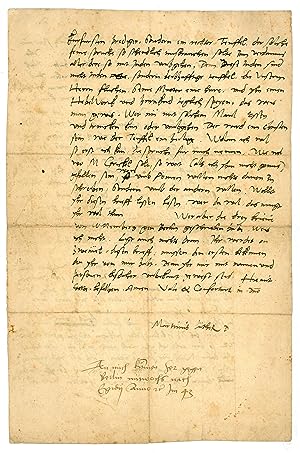
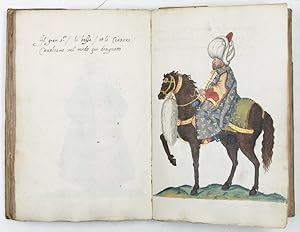
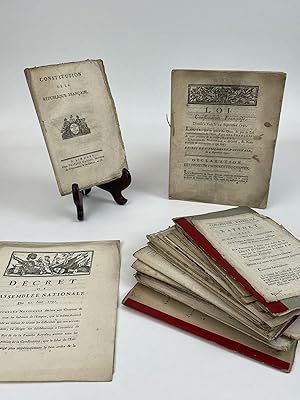
![Image du vendeur pour [Vitas patrum - germanice]. Der altväter leben. mis en vente par Antiquariat INLIBRIS Gilhofer Nfg. GmbH](https://pictures.abebooks.com/inventory/md/md31814086962.jpg)
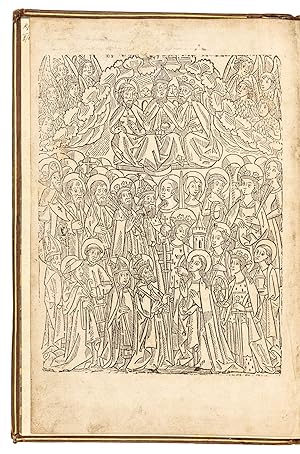
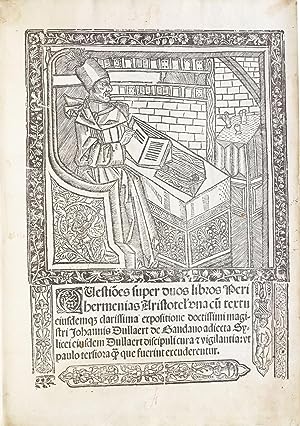
![Image du vendeur pour Le livre de Jehan Bocasse [sic] De la Louenge et vertu des nobles et clères dames traslaté et imprimé nouvellement à Paris. (In fine :) Cy finist Bocace des nobles et cleres femmes imprime a paris ce xxviij iour davril mil quatre cens quatre vingtz ? treize par Anthoine Verard libraire demourant a paris sur le pont nostre dame a lymage saint iehan levangeliste ou au palais au premier pilier devant la chappelle ou on ch?te la messe de messeigneurs les presidens. (Marque). mis en vente par Librairie Camille Sourget](https://pictures.abebooks.com/inventory/md/md31552531263.jpg)

![Image du vendeur pour Le vite de' piu eccellenti pittori, scultori, e architettori [The Lives of the Artists] mis en vente par Manhattan Rare Book Company, ABAA, ILAB](https://pictures.abebooks.com/inventory/md/md15268838412.jpg)
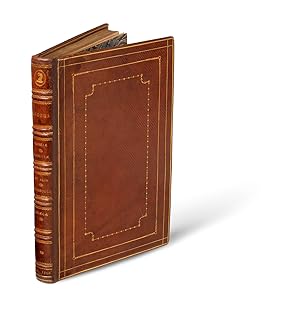
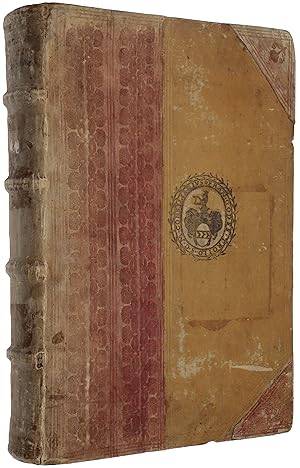
![Image du vendeur pour [Ship of Fooles] Stultifera nauis, qua omnium mortalium narratur stultitia, admodum vtilis & necessaria ab omnibus ad suam salutem perlegenda, è Latino sermone in nostrum vulgarem versa, & iam diligenter impressa. An. Do. 1570. The Ship of Fooles, wherin is shewed the folly of all states with diuers other workes adioyned vnto the same, very profitable and fruitfull for all men. Translated out of Latin into Englishe by Alexander Barclay priest mis en vente par Heritage Book Shop, ABAA](https://pictures.abebooks.com/inventory/md/md11250015304.jpg)
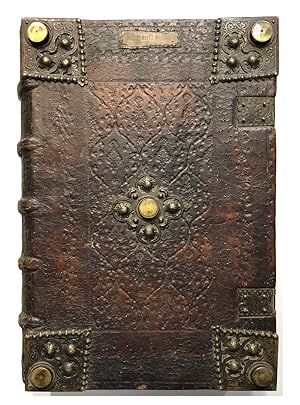
![Image du vendeur pour Sermon des grosz gelarten in gnade[n] erlauchte[n] doctoris Iohannis Thauleri predigerr ordens. Weisende auff den neheste[n] waren wegk. yn geiste czu wa[n]dern durch uberschwebe[n]den syn. Vnuoracht vo[n] geistes ynnige[n] worva[n]delt i[n] deutsch ma[n]che[n] me[n]sche[n] zu selikeit. [with]] Hystoria Thauleri mis en vente par Symonds Rare Books Ltd](https://pictures.abebooks.com/inventory/md/md30455996990.jpg)

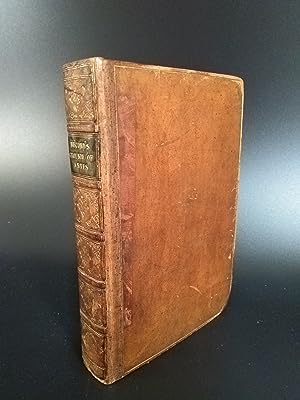
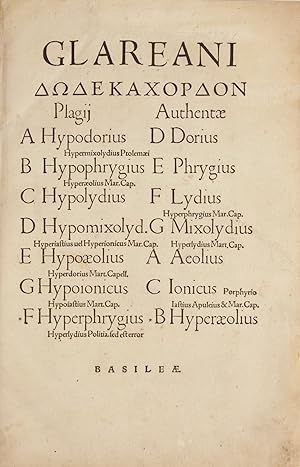
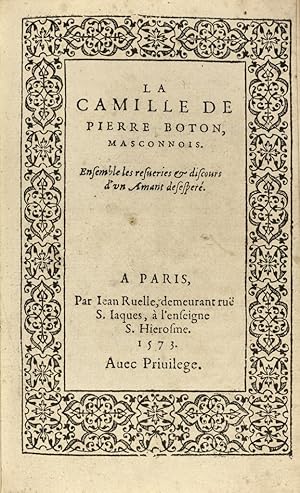
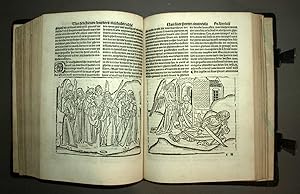
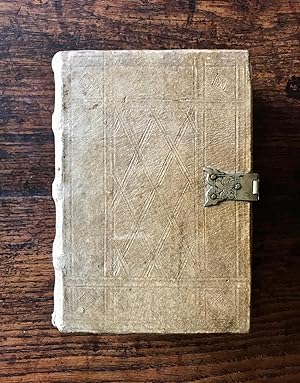
![Image du vendeur pour Apophthegmes, that is to saie, prompte, quicke, wittie and sente[n]cious saiyinges, of certaine emperours, kynges, capitaines, philosophiers mis en vente par Sokol Books Ltd. ABA ILAB](https://pictures.abebooks.com/inventory/md/md30771625845.jpg)
![Image du vendeur pour De viris illustribus urbis Romae (On the Illustrious Men of the City of Rome); list of ten kings of Egypt; epistolary formulas in Italian and Latin; [ANONYMOUS], Epistula Pilati ad Claudium (Letter of Pilate to Claudius); In Latin and Italian, manuscript on paper mis en vente par Les Enluminures (ABAA & ILAB)](https://pictures.abebooks.com/inventory/md/md31537023140.jpg)
